|
SNAP Library 2.0, Developer Reference
2013-05-13 16:33:57
SNAP, a general purpose, high performance system for analysis and manipulation of large networks
|
|
SNAP Library 2.0, Developer Reference
2013-05-13 16:33:57
SNAP, a general purpose, high performance system for analysis and manipulation of large networks
|
#include <timenet.h>
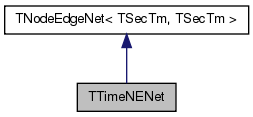
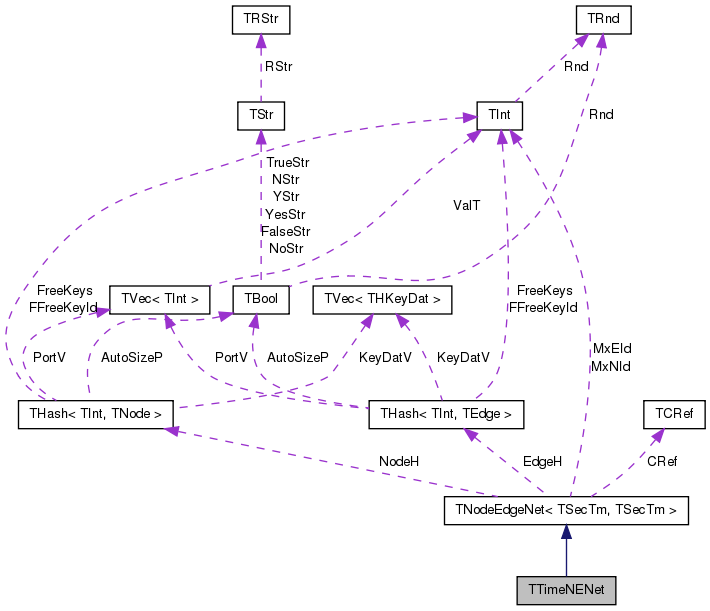
Public Types | |
| typedef TNodeEdgeNet< TSecTm, TSecTm > | TNet |
| typedef TPt< TNodeEdgeNet < TSecTm, TSecTm > > | PNet |
Public Member Functions | |
| TTimeNENet () | |
| TTimeNENet (const int &Nodes, const int &Edges) | |
| TTimeNENet (TSIn &SIn) | |
| TTimeNENet (const TTimeNENet &TimeNet) | |
| void | Save (TSOut &SOut) const |
| Saves the network to a (binary) stream SOut. | |
| TTimeNENet & | operator= (const TTimeNENet &TimeNet) |
| PTimeNet | GetTimeNet () const |
| PTimeNENet | Get1stEdgeNet () const |
| PTimeNENet | GetSubGraph (const TIntV &NIdV) const |
| PTimeNENet | GetESubGraph (const TIntV &EIdV) const |
| PTimeNENet | GetGraphUpToTm (const TSecTm &MaxEdgeTm) const |
| void | SortNodeEdgeTimes () |
| void | UpdateNodeTimes () |
| void | SetNodeTmToFirstEdgeTm () |
| void | SetRndEdgeTimes (const int &MinTmEdge=0) |
| void | DumpTimeStat () const |
| void | GetNIdByTm (TIntV &NIdV) const |
| void | GetEIdByTm (TIntV &EIdV) const |
| void | GetTmBuckets (const TTmUnit &GroupBy, TTimeNet::TTmBucketV &TmBucketV) const |
| void | GetEdgeTmBuckets (const TTmUnit &GroupBy, TTimeNet::TTmBucketV &TmBucketV) const |
| void | GetNodeBuckets (const int NodesPerBucket, TTimeNet::TTmBucketV &TmBucketV) const |
| void | GetEdgeBuckets (const int EdgesPerBucket, TTimeNet::TTmBucketV &TmBucketV) const |
| int | GetTriadEdges (TIntV &TriadEIdV) const |
| PGStatVec | TimeGrowth (const TTmUnit &TimeStep, const TFSet &TakeStat, const TSecTm &StartTm=TSecTm(1)) const |
| PGStatVec | TimeGrowth (const TStr &FNmPref, const TStr &Desc, const TFSet &TakeStat, const int &NDiamRuns, const TTmUnit &TmUnit, const int &TakeNTmUnits, const bool &LinkBWays) const |
| void | PlotEffDiam (const TStr &FNmPref, const TStr &Desc, const TTmUnit &GroupBy, const TSecTm &StartTm, const int &NDiamRuns=10, const bool &OnlyWcc=false) const |
| void | PlotMissingPast (const TStr &FNmPref, const TStr &Desc, const TTmUnit &TmUnit, const TSecTm &DelPreTmEdges, const TSecTm &PostTmDiam, const bool &LinkBWays) |
| void | SaveEdgeTm (const TStr &EdgeFNm, const bool &RenumberNId=false, const bool &RelativeTm=false) const |
Static Public Member Functions | |
| static PTimeNENet | New () |
| Static constructor that returns a pointer to the network. Call: TPt <TNodeEdgeNet<TNodeData, TEdgeData> > Net = TNodeEdgeNet<TNodeData, TEdgeData>::New(). | |
| static PTimeNENet | New (const int &Nodes, const int &Edges) |
| static PTimeNENet | Load (TSIn &SIn) |
| Static constructor that loads the network from a stream SIn and returns a pointer to it. | |
| static PTimeNENet | GetSmallNet () |
| static PTimeNENet | GetGnmRndNet (const int &Nodes, const int &Edges) |
| static PTimeNENet | GetPrefAttach (const int &Nodes, const int &Edges, const double &GammaIn, const double &GammaOut) |
| static PTimeNENet | GetPrefAttach (const int &Nodes, const int &OutDeg) |
| static PTimeNENet | LoadFlickr (const TStr &NodeFNm, const TStr &EdgeFNm) |
| static PTimeNENet | LoadEdgeTm (const TStr &EdgeFNm, const int &SrcFld=0, const int &DstFld=1, const int &TimeFld=2, const TSsFmt &Separator=ssfTabSep) |
Friends | |
| class | TPt< TTimeNENet > |
| typedef TPt<TNodeEdgeNet<TSecTm, TSecTm> > TTimeNENet::PNet |
Reimplemented from TNodeEdgeNet< TSecTm, TSecTm >.
| typedef TNodeEdgeNet<TSecTm, TSecTm> TTimeNENet::TNet |
Reimplemented from TNodeEdgeNet< TSecTm, TSecTm >.
| TTimeNENet::TTimeNENet | ( | ) | [inline] |
| TTimeNENet::TTimeNENet | ( | const int & | Nodes, |
| const int & | Edges | ||
| ) | [inline] |
| TTimeNENet::TTimeNENet | ( | TSIn & | SIn | ) | [inline] |
| TTimeNENet::TTimeNENet | ( | const TTimeNENet & | TimeNet | ) | [inline] |
| void TTimeNENet::DumpTimeStat | ( | ) | const |
Definition at line 759 of file timenet.cpp.
References TNodeEdgeNet< TSecTm, TSecTm >::BegEI(), TNodeEdgeNet< TSecTm, TSecTm >::BegNI(), TStr::CStr(), TNodeEdgeNet< TSecTm, TSecTm >::EndEI(), TNodeEdgeNet< TSecTm, TSecTm >::EndNI(), TSecTm::GetStr(), and TSecTm::IsDef().
{
TSecTm MnNodeTm, MxNodeTm;
TSecTm MnEdgeTm, MxEdgeTm;
for (TNodeI NI = BegNI(); NI < EndNI(); NI++) {
const TSecTm NodeTm = NI();
if (! MnNodeTm.IsDef() || MnNodeTm>NodeTm) { MnNodeTm = NodeTm; }
if (! MxNodeTm.IsDef() || MxNodeTm<NodeTm) { MxNodeTm = NodeTm; }
}
printf("Node times:\n %s\n %s\n", MnNodeTm.GetStr().CStr(), MxNodeTm.GetStr().CStr());
for (TEdgeI EI= BegEI(); EI < EndEI(); EI++) {
const TSecTm EdgeTm = EI();
if (! MnEdgeTm.IsDef() || MnEdgeTm>EdgeTm) { MnEdgeTm = EdgeTm; }
if (! MxEdgeTm.IsDef() || MxEdgeTm<EdgeTm) { MxEdgeTm = EdgeTm; }
}
printf("Edge times:\n %s\n %s\n", MnEdgeTm.GetStr().CStr(), MxEdgeTm.GetStr().CStr());
}
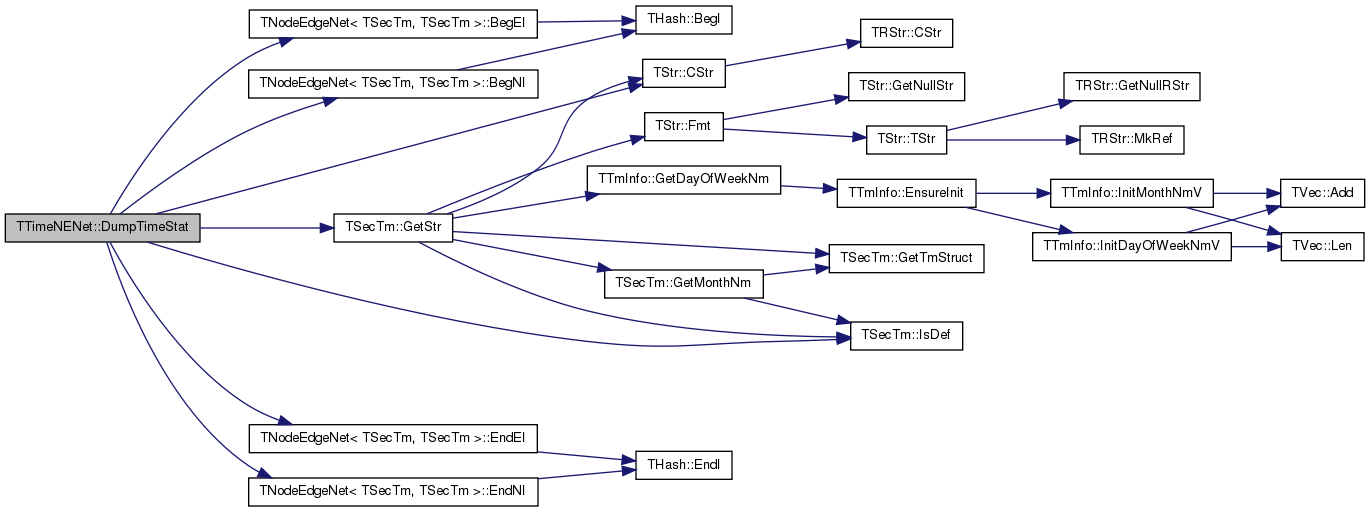
| PTimeNENet TTimeNENet::Get1stEdgeNet | ( | ) | const |
Definition at line 627 of file timenet.cpp.
References THashSet< TKey, THashFunc >::AddKey(), TNodeEdgeNet< TSecTm, TSecTm >::BegNI(), TNodeEdgeNet< TSecTm, TSecTm >::EndNI(), TNodeEdgeNet< TSecTm, TSecTm >::GetEdges(), TNodeEdgeNet< TSecTm, TSecTm >::GetEI(), GetEIdByTm(), TNodeEdgeNet< TSecTm, TSecTm >::GetNodes(), THashSet< TKey, THashFunc >::IsKey(), TVec< TVal, TSizeTy >::Len(), TMath::Mn(), TMath::Mx(), and New().
{
PTimeNENet Net = TTimeNENet::New();
Net->Reserve(GetNodes(), -1);
for (TNodeI NI = BegNI(); NI < EndNI(); NI++) {
Net->AddNode(NI.GetId(), NI.GetDat()); }
TIntV EIdV; GetEIdByTm(EIdV);
TIntPrSet EdgeSet(GetEdges());
for (int edge = 0; edge < EIdV.Len(); edge++) {
const TEdgeI EI = GetEI(EIdV[edge]);
const int Src = EI.GetSrcNId();
const int Dst = EI.GetDstNId();
if (Src==Dst || EdgeSet.IsKey(TIntPr(TMath::Mn(Src, Dst), TMath::Mx(Src, Dst)))) { continue; } // take only 1st edge
EdgeSet.AddKey(TIntPr(TMath::Mn(Src, Dst), TMath::Mx(Src, Dst)));
Net->AddEdge(EI);
}
return Net;
}
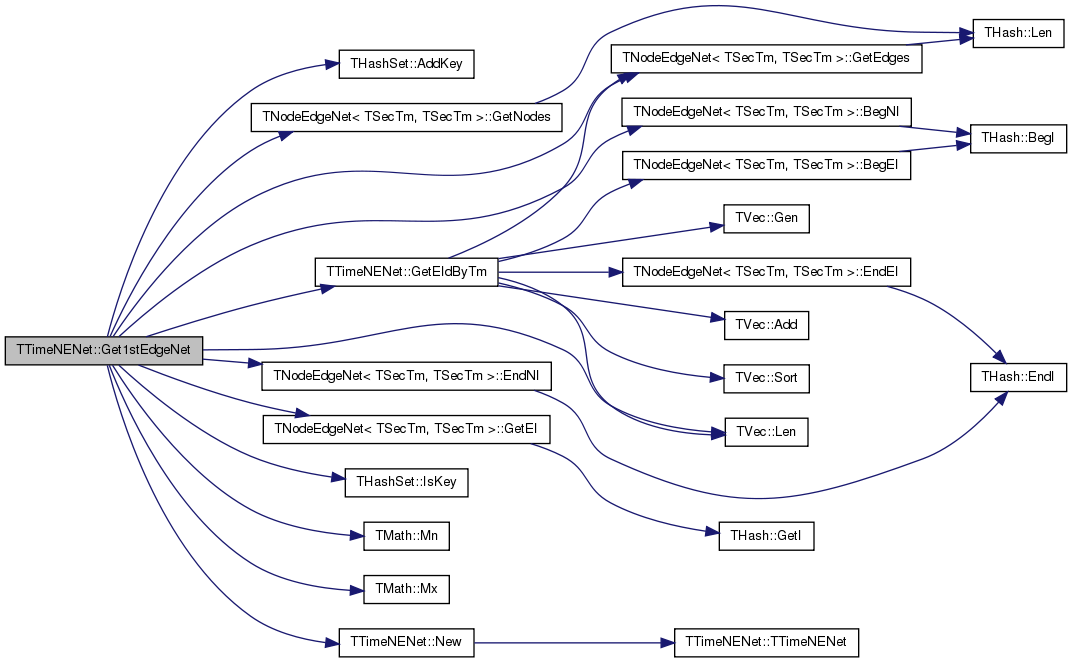
| void TTimeNENet::GetEdgeBuckets | ( | const int | EdgesPerBucket, |
| TTimeNet::TTmBucketV & | TmBucketV | ||
| ) | const |
Definition at line 844 of file timenet.cpp.
References TVec< TVal, TSizeTy >::Add(), TVec< TVal, TSizeTy >::Gen(), GetEIdByTm(), and TVec< TVal, TSizeTy >::Len().
{
TIntV EIdV; GetEIdByTm(EIdV);
TmBucketV.Gen(EIdV.Len()/EdgesPerBucket + 1, 0);
for (int i = 0; i < EIdV.Len(); i++) {
const int b = i/EdgesPerBucket;
if (TmBucketV.Len() <= b) { TmBucketV.Add(TTimeNet::TTmBucket(TSecTm(b))); }
TmBucketV[b].NIdV.Add(EIdV[i]);
}
}
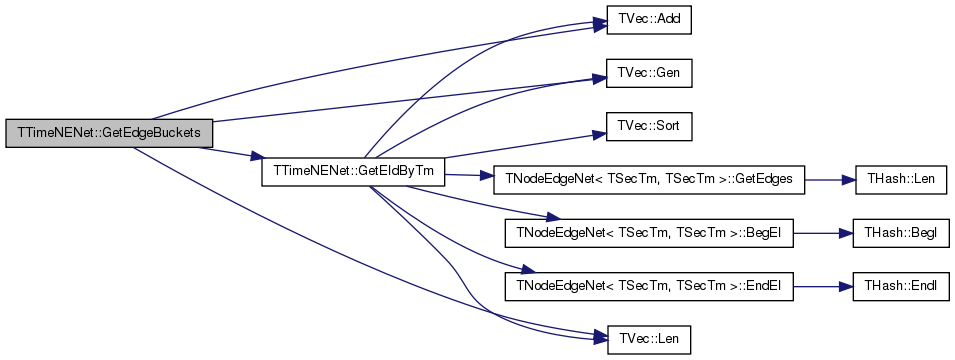
| void TTimeNENet::GetEdgeTmBuckets | ( | const TTmUnit & | GroupBy, |
| TTimeNet::TTmBucketV & | TmBucketV | ||
| ) | const |
Definition at line 815 of file timenet.cpp.
References TVec< TVal, TSizeTy >::Add(), THash< TKey, TDat, THashFunc >::AddKey(), TTimeNet::TTmBucket::BegTm, TVec< TVal, TSizeTy >::Gen(), TSecTm::GetAbsSecs(), THash< TKey, TDat, THashFunc >::GetDat(), TNodeEdgeNet< TSecTm, TSecTm >::GetEDat(), GetEIdByTm(), THash< TKey, TDat, THashFunc >::GetKeyDatPrV(), THash< TKey, TDat, THashFunc >::IsKey(), TVec< TVal, TSizeTy >::Len(), TTimeNet::TTmBucket::NIdV, TSecTm::Round(), and TVec< TVal, TSizeTy >::Sort().
Referenced by PlotEffDiam(), and TimeGrowth().
{
THash<TInt, TIntV> TmIdToEIdVH;
TIntV EIdV; GetEIdByTm(EIdV);
for (int e = 0; e < EIdV.Len(); e++) {
const int TmId = GetEDat(EIdV[e]).Round(TmUnit).GetAbsSecs();
if (! TmIdToEIdVH.IsKey(TmId)) { TmIdToEIdVH.AddKey(TmId); }
TmIdToEIdVH.GetDat(TmId).Add(EIdV[e]);
}
TVec<TPair<TInt, TIntV> > TmIdEIdVV;
TmIdToEIdVH.GetKeyDatPrV(TmIdEIdVV);
TmIdEIdVV.Sort();
TmBucketV.Gen(TmIdEIdVV.Len());
for (int i = 0; i < TmIdEIdVV.Len(); i++) {
TTimeNet::TTmBucket& Bucket = TmBucketV[i];
Bucket.BegTm = TmIdEIdVV[i].Val1;
Bucket.NIdV = TmIdEIdVV[i].Val2;
}
}
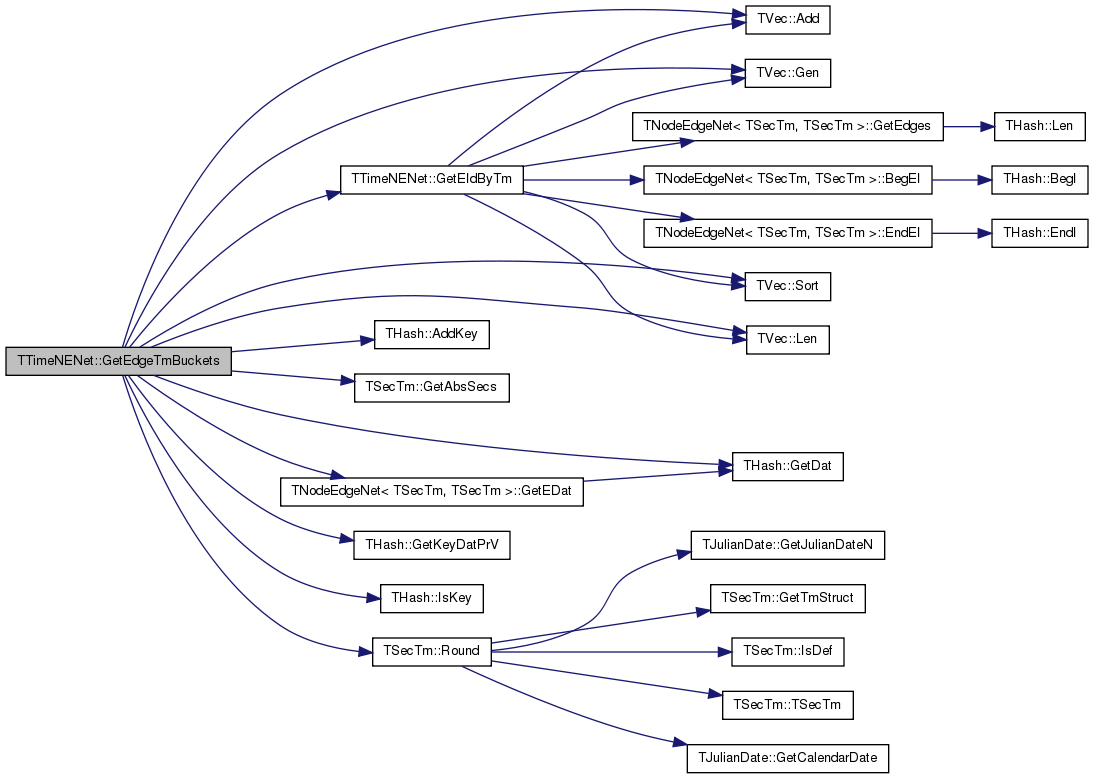

| void TTimeNENet::GetEIdByTm | ( | TIntV & | EIdV | ) | const |
Definition at line 786 of file timenet.cpp.
References TVec< TVal, TSizeTy >::Add(), TNodeEdgeNet< TSecTm, TSecTm >::BegEI(), TNodeEdgeNet< TSecTm, TSecTm >::EndEI(), TVec< TVal, TSizeTy >::Gen(), TNodeEdgeNet< TSecTm, TSecTm >::GetEdges(), TVec< TVal, TSizeTy >::Len(), and TVec< TVal, TSizeTy >::Sort().
Referenced by Get1stEdgeNet(), GetEdgeBuckets(), GetEdgeTmBuckets(), GetTriadEdges(), SaveEdgeTm(), and SetRndEdgeTimes().
{
TVec<TKeyDat<TSecTm, TInt> > TmToEIdV(GetEdges(), 0);
for (TEdgeI EI= BegEI(); EI < EndEI(); EI++) {
TmToEIdV.Add(TKeyDat<TSecTm, TInt>(EI.GetDat(), EI.GetId())); }
TmToEIdV.Sort();
EIdV.Gen(GetEdges(), 0);
for (int i = 0; i < TmToEIdV.Len(); i++) {
EIdV.Add(TmToEIdV[i].Dat); }
}
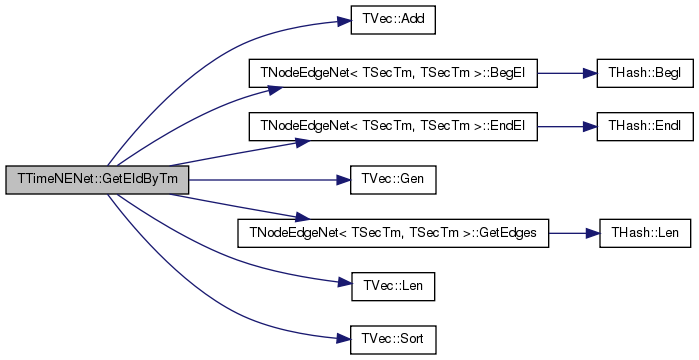
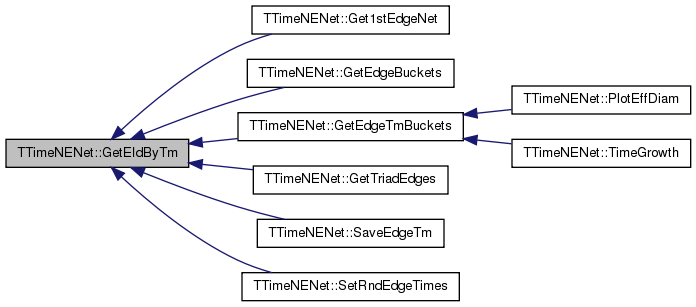
| PTimeNENet TTimeNENet::GetESubGraph | ( | const TIntV & | EIdV | ) | const |
Definition at line 666 of file timenet.cpp.
References TNodeEdgeNet< TNodeData, TEdgeData >::AddEdge(), TNodeEdgeNet< TNodeData, TEdgeData >::AddNode(), TNodeEdgeNet< TNodeData, TEdgeData >::Defrag(), TNodeEdgeNet< TSecTm, TSecTm >::GetEI(), TNodeEdgeNet< TSecTm, TSecTm >::GetNI(), TNodeEdgeNet< TNodeData, TEdgeData >::IsNode(), TVec< TVal, TSizeTy >::Len(), New(), and TNodeEdgeNet< TNodeData, TEdgeData >::Reserve().
Referenced by TimeGrowth().
{
PTimeNENet NewNetPt = TTimeNENet::New();
TTimeNENet& NewNet = *NewNetPt;
NewNet.Reserve(-1, EIdV.Len());
for (int edge = 0; edge < EIdV.Len(); edge++) {
const TEdgeI Edge = GetEI(EIdV[edge]);
if (! NewNet.IsNode(Edge.GetSrcNId()))
NewNet.AddNode(GetNI(Edge.GetSrcNId()));
if (! NewNet.IsNode(Edge.GetDstNId()))
NewNet.AddNode(GetNI(Edge.GetDstNId()));
NewNet.AddEdge(Edge);
}
NewNet.Defrag();
return NewNetPt;
}
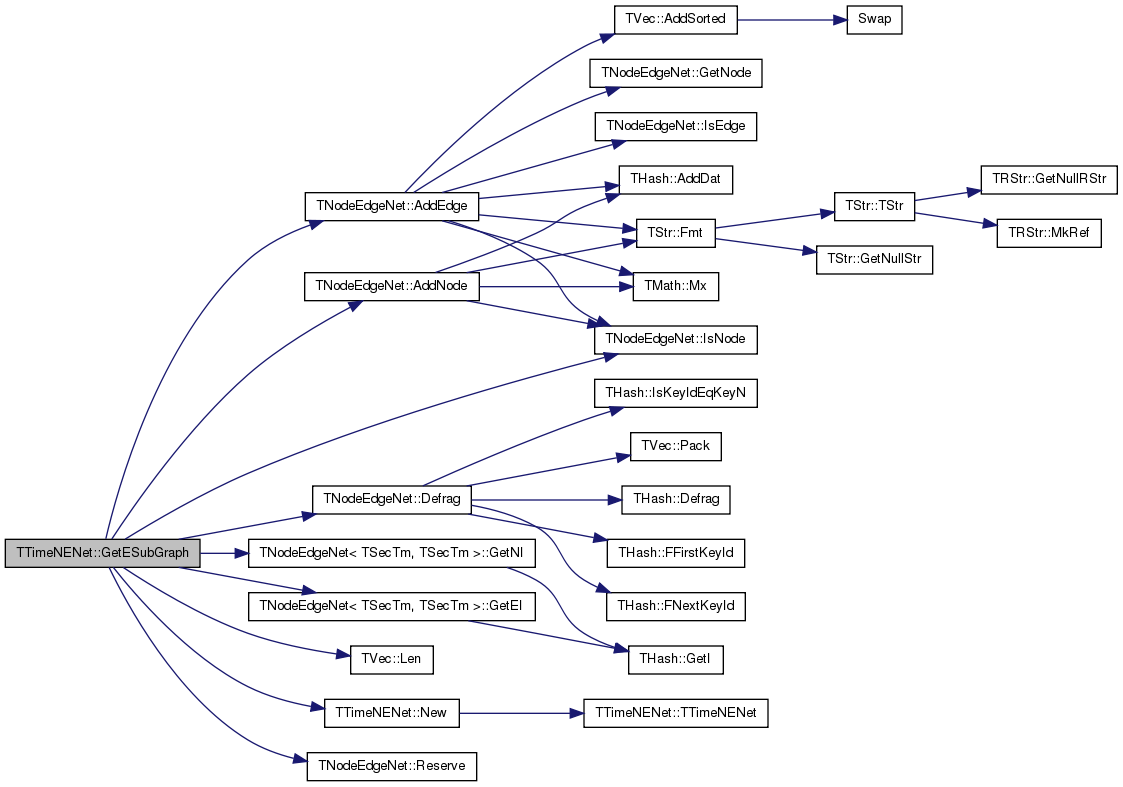

| PTimeNENet TTimeNENet::GetGnmRndNet | ( | const int & | Nodes, |
| const int & | Edges | ||
| ) | [static] |
Definition at line 1224 of file timenet.cpp.
References TRnd::GetUniDevInt(), New(), and TInt::Rnd.
{
printf("Generating G_nm(%d, %d)\n", Nodes, Edges);
int Src, Dst;
PTimeNENet Net = TTimeNENet::New();
Net->Reserve(Nodes, Edges);
for (int e = 0; e < Edges; e++) {
Src = TInt::Rnd.GetUniDevInt(Nodes);
Dst = TInt::Rnd.GetUniDevInt(Nodes);
while (Dst == Src || Net->IsEdge(Src, Dst)) {
Dst = TInt::Rnd.GetUniDevInt(Nodes); }
if (! Net->IsNode(Src)) { Net->AddNode(Src, TSecTm(e)); }
if (! Net->IsNode(Dst)) { Net->AddNode(Dst, TSecTm(e)); }
Net->AddEdge(Src, Dst, -1, TSecTm(e));
}
return Net;
}

| PTimeNENet TTimeNENet::GetGraphUpToTm | ( | const TSecTm & | MaxEdgeTm | ) | const |
Definition at line 683 of file timenet.cpp.
References TNodeEdgeNet< TNodeData, TEdgeData >::AddEdge(), TNodeEdgeNet< TNodeData, TEdgeData >::AddNode(), TNodeEdgeNet< TSecTm, TSecTm >::BegEI(), TNodeEdgeNet< TNodeData, TEdgeData >::Defrag(), TNodeEdgeNet< TSecTm, TSecTm >::EndEI(), TNodeEdgeNet< TSecTm, TSecTm >::GetNI(), IAssert, TSecTm::IsDef(), TNodeEdgeNet< TNodeData, TEdgeData >::IsNode(), and New().
{
PTimeNENet NewNetPt = TTimeNENet::New();
TTimeNENet& NewNet = *NewNetPt;
TSecTm PrevTm;
for (TEdgeI EI = BegEI(); EI < EndEI(); EI++) {
if (EI() > MaxEdgeTm) { break; }
if (! NewNet.IsNode(EI.GetSrcNId()))
NewNet.AddNode(GetNI(EI.GetSrcNId()));
if (! NewNet.IsNode(EI.GetDstNId()))
NewNet.AddNode(GetNI(EI.GetDstNId()));
NewNet.AddEdge(EI);
IAssert(! PrevTm.IsDef() || PrevTm <= EI()); // edge times must be sorted
PrevTm = EI();
}
NewNet.Defrag();
return NewNetPt;
}
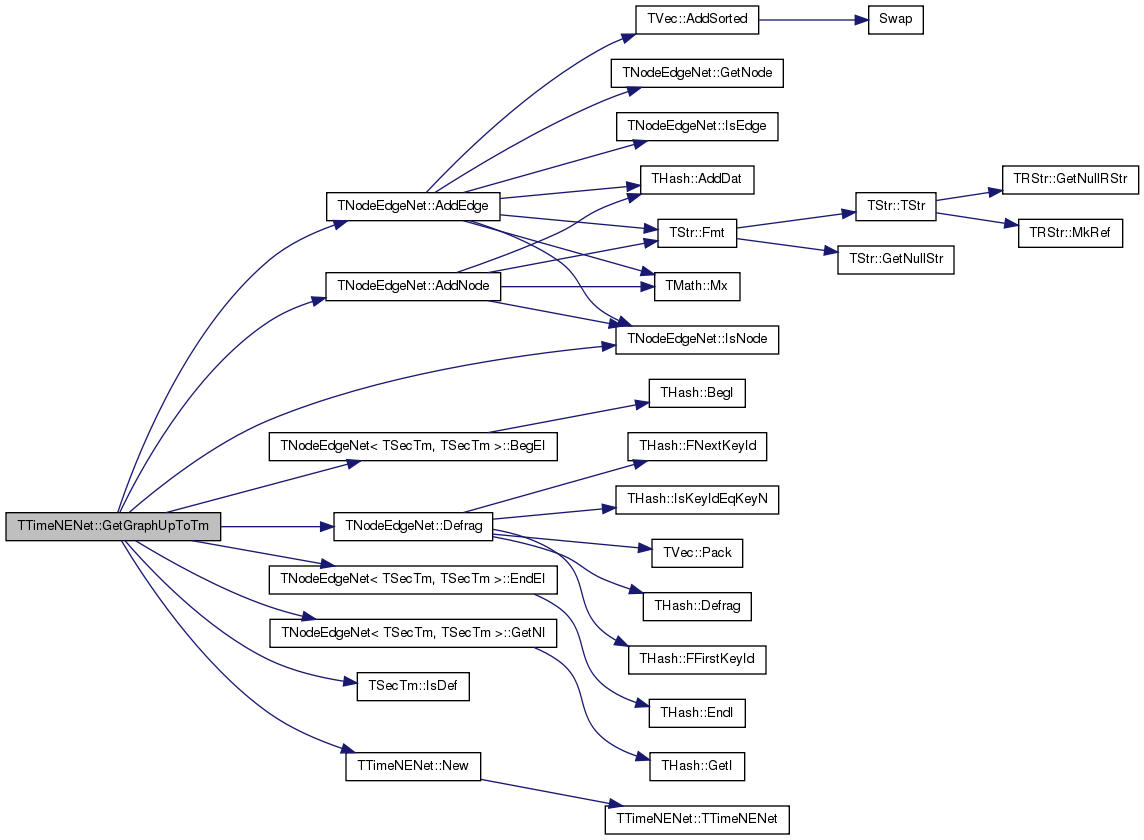
| void TTimeNENet::GetNIdByTm | ( | TIntV & | NIdV | ) | const |
Definition at line 776 of file timenet.cpp.
References TVec< TVal, TSizeTy >::Add(), TNodeEdgeNet< TSecTm, TSecTm >::BegNI(), TNodeEdgeNet< TSecTm, TSecTm >::EndNI(), TVec< TVal, TSizeTy >::Gen(), TNodeEdgeNet< TSecTm, TSecTm >::GetNodes(), TVec< TVal, TSizeTy >::Len(), and TVec< TVal, TSizeTy >::Sort().
Referenced by GetNodeBuckets(), and GetTmBuckets().
{
TVec<TKeyDat<TSecTm, TInt> > TmToNIdV(GetNodes(), 0);
for (TNodeI NodeI = BegNI(); NodeI < EndNI(); NodeI++) {
TmToNIdV.Add(TKeyDat<TSecTm, TInt>(NodeI.GetDat(), NodeI.GetId())); }
TmToNIdV.Sort();
NIdV.Gen(GetNodes(), 0);
for (int i = 0; i < TmToNIdV.Len(); i++) {
NIdV.Add(TmToNIdV[i].Dat); }
}
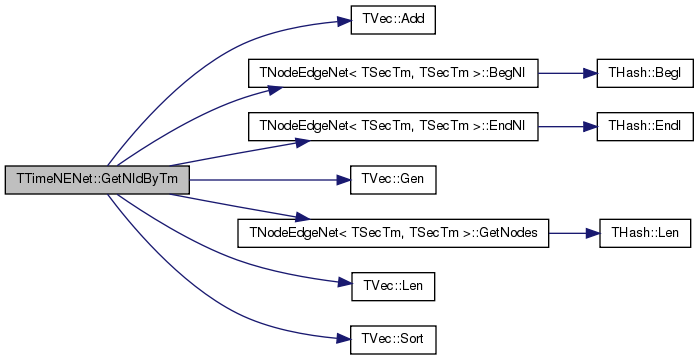

| void TTimeNENet::GetNodeBuckets | ( | const int | NodesPerBucket, |
| TTimeNet::TTmBucketV & | TmBucketV | ||
| ) | const |
Definition at line 834 of file timenet.cpp.
References TVec< TVal, TSizeTy >::Add(), TVec< TVal, TSizeTy >::Gen(), GetNIdByTm(), and TVec< TVal, TSizeTy >::Len().
{
TIntV NIdV; GetNIdByTm(NIdV);
TmBucketV.Gen(NIdV.Len() / NodesPerBucket + 1, 0);
for (int i = 0; i < NIdV.Len(); i++) {
const int b = i/NodesPerBucket;
if (TmBucketV.Len() <= b) { TmBucketV.Add(TTimeNet::TTmBucket(TSecTm(b))); }
TmBucketV[b].NIdV.Add(NIdV[i]);
}
}
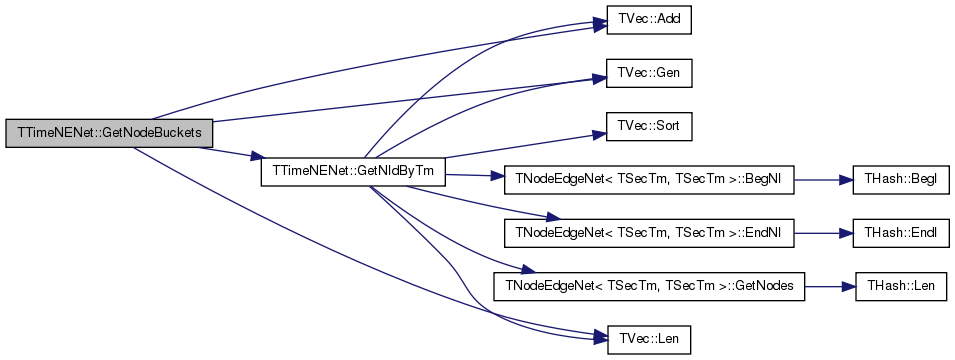
| PTimeNENet TTimeNENet::GetPrefAttach | ( | const int & | Nodes, |
| const int & | Edges, | ||
| const double & | GammaIn, | ||
| const double & | GammaOut | ||
| ) | [static] |
Definition at line 1242 of file timenet.cpp.
References TVec< TVal, TSizeTy >::Add(), TRnd::GetUniDevInt(), IAssert, TVec< TVal, TSizeTy >::Len(), New(), and TInt::Rnd.
{
const double Alpha = Nodes/double(Edges);
printf("Generating PA(%d, %d), with slope in:%.1f, out: %.1f\n", Nodes, Edges,
2+GammaIn/(Alpha/(1-Alpha)), 2+GammaOut/(Alpha/(1-Alpha)));
// init
int nodes=0, edges=0, time=0, iter=0;
TIntV OutW(Edges, 0), InW(Edges, 0);
PTimeNENet Net = TTimeNENet::New();
Net->Reserve(Nodes, Edges);
// 1st node
Net->AddNode(0, TSecTm(time++)); nodes++;
OutW.Add(0); InW.Add(0);
while (edges < Edges) {
int Src=-1, Dst=-1; iter++;
if (TInt::Rnd.GetUniDev() < Alpha) {
if (nodes < Nodes) {
IAssert(Net->AddNode(nodes, TSecTm(time++)));
nodes++; }
} else {
if (TInt::Rnd.GetUniDev() < nodes*GammaIn/double(edges+nodes*GammaIn)) {
Src = TInt::Rnd.GetUniDevInt(nodes); }
else { Src = OutW[TInt::Rnd.GetUniDevInt(OutW.Len())]; }
if (TInt::Rnd.GetUniDev() < nodes*GammaOut/double(edges+nodes*GammaOut)) {
Dst = TInt::Rnd.GetUniDevInt(nodes); }
else { Dst = InW[TInt::Rnd.GetUniDevInt(InW.Len())]; }
}
if (Src == Dst || Net->IsEdge(Src, Dst)) {
continue;
}
//printf("%d/%d %d %d\n", edges, iter, Src, Dst);
if (! Net->IsNode(Src)) { Net->AddNode(Src, TSecTm(time++)); nodes++; }
if (! Net->IsNode(Dst)) { Net->AddNode(Dst, TSecTm(time++)); nodes++; }
Net->AddEdge(Src, Dst, -1, TSecTm(time++));
OutW.Add(Src); InW.Add(Dst); edges++;
}
for (int node = 0; node < Nodes; node++) {
if (! Net->IsNode(node)) {
Net->AddNode(node, TSecTm(time++)); }
}
return Net;
}

| PTimeNENet TTimeNENet::GetPrefAttach | ( | const int & | Nodes, |
| const int & | OutDeg | ||
| ) | [static] |
Definition at line 1284 of file timenet.cpp.
References TVec< TVal, TSizeTy >::Add(), THashSet< TKey, THashFunc >::AddKey(), THashSet< TKey, THashFunc >::Clr(), TVec< TVal, TSizeTy >::Len(), THashSet< TKey, THashFunc >::Len(), New(), and TInt::Rnd.
{
printf("Generating PA, nodes:%d, out-deg:%d\n", Nodes, OutDeg);
// init
int time=0;
PTimeNENet Net = TTimeNENet::New();
Net->Reserve(Nodes, OutDeg*Nodes);
Net->AddNode(0, TSecTm(++time)); Net->AddNode(1, TSecTm(++time));
Net->AddEdge(0, 1, -1, TSecTm(++time));
TIntV NIdV; NIdV.Add(0); NIdV.Add(1);
TIntSet NodeSet;
for (int node = 2; node <= Nodes; node++) {
NodeSet.Clr(false);
while (NodeSet.Len() < OutDeg && NodeSet.Len() < node) {
NodeSet.AddKey(NIdV[TInt::Rnd.GetUniDevInt(NIdV.Len())]);
}
const int N = Net->AddNode(node, TSecTm(++time));
for (int i = 0; i < NodeSet.Len(); i++) {
Net->AddEdge(node, NodeSet[i], -1, TSecTm(++time));
NIdV.Add(N); NIdV.Add(NodeSet[i]);
}
}
return Net;
}
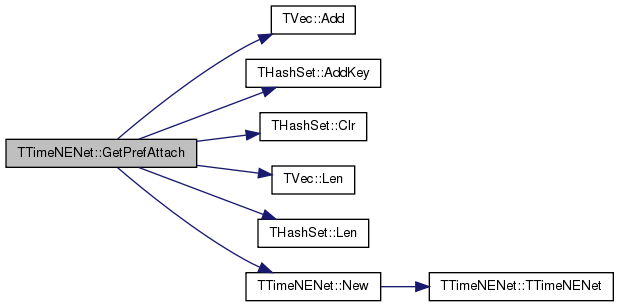
| PTimeNENet TTimeNENet::GetSmallNet | ( | ) | [static] |
Definition at line 1329 of file timenet.cpp.
References New().
{
PTimeNENet Net = TTimeNENet::New();
for (int i = 1; i <= 6; i++) {
Net->AddNode(i, TSecTm(0)); }
int tm = 1;
Net->AddEdge(1, 2, -1, TSecTm(tm++));
Net->AddEdge(3, 4, -1, TSecTm(tm++));
Net->AddEdge(3, 1, -1, TSecTm(tm++));
Net->AddEdge(5, 6, -1, TSecTm(tm++));
Net->AddEdge(6, 4, -1, TSecTm(tm++));
Net->AddEdge(5, 3, -1, TSecTm(tm++));
Net->AddEdge(5, 4, -1, TSecTm(tm++));
Net->AddEdge(5, 2, -1, TSecTm(tm++));
return Net;
}

| PTimeNENet TTimeNENet::GetSubGraph | ( | const TIntV & | NIdV | ) | const |
Definition at line 645 of file timenet.cpp.
References TNodeEdgeNet< TNodeData, TEdgeData >::AddEdge(), TNodeEdgeNet< TNodeData, TEdgeData >::AddNode(), TNodeEdgeNet< TNodeData, TEdgeData >::Defrag(), TNodeEdgeNet< TSecTm, TSecTm >::GetEI(), TNodeEdgeNet< TSecTm, TSecTm >::GetNDat(), TNodeEdgeNet< TSecTm, TSecTm >::GetNI(), TNodeEdgeNet< TNodeData, TEdgeData >::IsNode(), TVec< TVal, TSizeTy >::Len(), New(), and TNodeEdgeNet< TNodeData, TEdgeData >::Reserve().
{
PTimeNENet NewNetPt = TTimeNENet::New();
TTimeNENet& NewNet = *NewNetPt;
NewNet.Reserve(NIdV.Len(), -1);
int node, edge;
TNodeI NI;
for (node = 0; node < NIdV.Len(); node++) {
NewNet.AddNode(NIdV[node], GetNDat(NIdV[node]));
}
for (node = 0; node < NIdV.Len(); node++) {
NI = GetNI(NIdV[node]);
for (edge = 0; edge < NI.GetOutDeg(); edge++) {
const TEdgeI EI = GetEI(NI.GetOutEId(edge));
if (NewNet.IsNode(EI.GetDstNId())) {
NewNet.AddEdge(EI); }
}
}
NewNet.Defrag();
return NewNetPt;
}
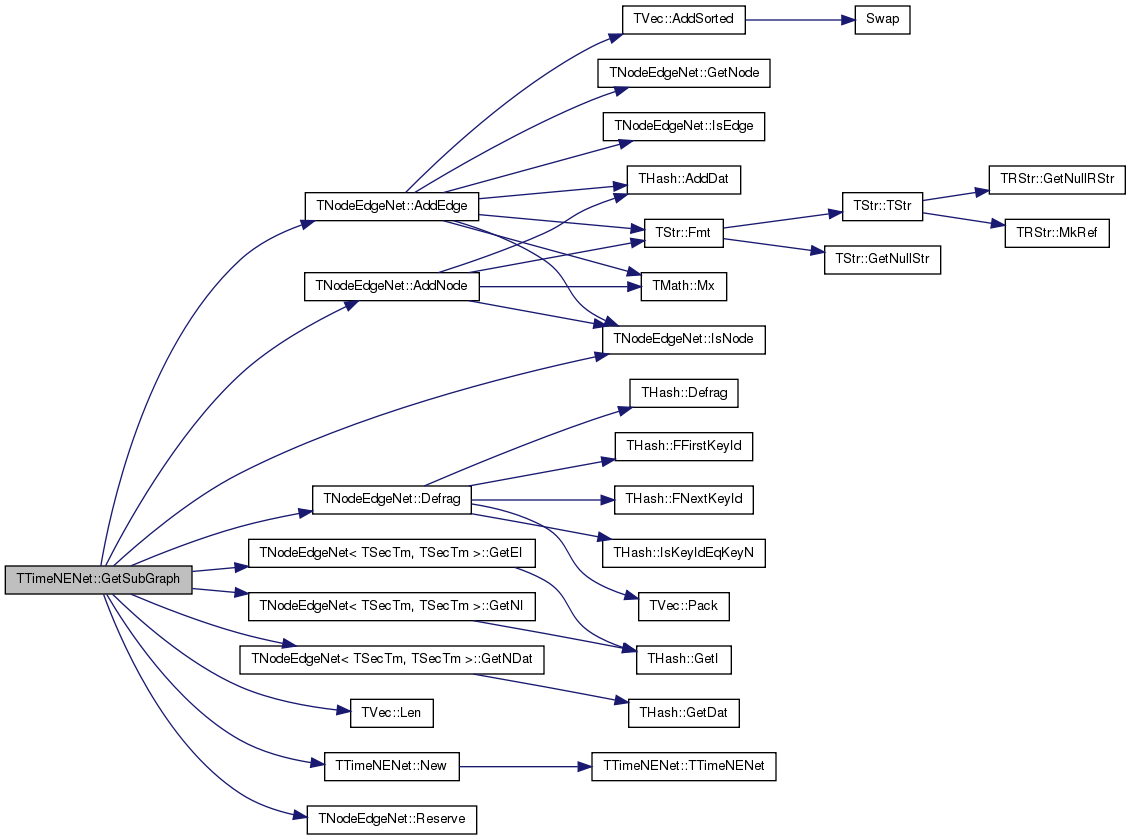
| PTimeNet TTimeNENet::GetTimeNet | ( | ) | const |
Definition at line 610 of file timenet.cpp.
References TNodeEdgeNet< TSecTm, TSecTm >::BegEI(), TNodeEdgeNet< TSecTm, TSecTm >::BegNI(), TNodeEdgeNet< TSecTm, TSecTm >::EndEI(), TNodeEdgeNet< TSecTm, TSecTm >::EndNI(), TNodeEdgeNet< TSecTm, TSecTm >::GetNodes(), and New().
{
PTimeNet NewNet = TTimeNet::New();
NewNet->Reserve(GetNodes(), -1);
for (TNodeI NI = BegNI(); NI < EndNI(); NI++) {
NewNet->AddNode(NI.GetId(), NI.GetDat());
}
for (TEdgeI EI = BegEI(); EI < EndEI(); EI++) {
const int src = EI.GetSrcNId();
const int dst = EI.GetDstNId();
if (! NewNet->IsEdge(src, dst)) {
NewNet->AddEdge(src, dst); }
}
NewNet->Defrag();
return NewNet;
}
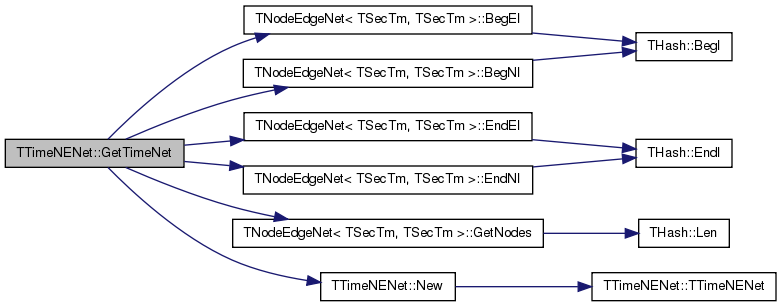
| void TTimeNENet::GetTmBuckets | ( | const TTmUnit & | GroupBy, |
| TTimeNet::TTmBucketV & | TmBucketV | ||
| ) | const |
Definition at line 796 of file timenet.cpp.
References TVec< TVal, TSizeTy >::Add(), THash< TKey, TDat, THashFunc >::AddKey(), TTimeNet::TTmBucket::BegTm, TVec< TVal, TSizeTy >::Gen(), TSecTm::GetAbsSecs(), THash< TKey, TDat, THashFunc >::GetDat(), THash< TKey, TDat, THashFunc >::GetKeyDatPrV(), TNodeEdgeNet< TSecTm, TSecTm >::GetNDat(), GetNIdByTm(), THash< TKey, TDat, THashFunc >::IsKey(), TVec< TVal, TSizeTy >::Len(), TTimeNet::TTmBucket::NIdV, TSecTm::Round(), and TVec< TVal, TSizeTy >::Sort().
{
THash<TInt, TIntV> TmIdToNIdVH;
TIntV NIdV; GetNIdByTm(NIdV);
for (int n = 0; n < NIdV.Len(); n++) {
const int TmId = GetNDat(NIdV[n]).Round(TmUnit).GetAbsSecs();
if (! TmIdToNIdVH.IsKey(TmId)) { TmIdToNIdVH.AddKey(TmId); }
TmIdToNIdVH.GetDat(TmId).Add(NIdV[n]);
}
TVec<TPair<TInt, TIntV> > TmIdNIdVV;
TmIdToNIdVH.GetKeyDatPrV(TmIdNIdVV);
TmIdNIdVV.Sort();
TmBucketV.Gen(TmIdNIdVV.Len());
for (int i = 0; i < TmIdNIdVV.Len(); i++) {
TTimeNet::TTmBucket& Bucket = TmBucketV[i];
Bucket.BegTm = TmIdNIdVV[i].Val1;
Bucket.NIdV = TmIdNIdVV[i].Val2;
}
}
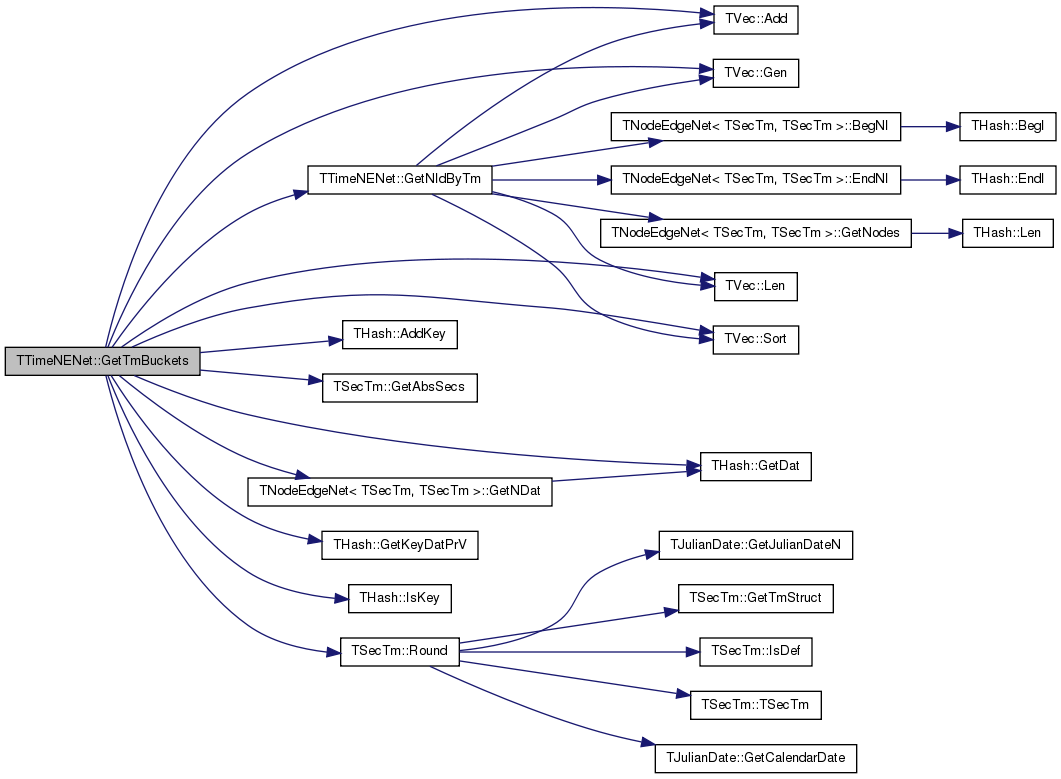
| int TTimeNENet::GetTriadEdges | ( | TIntV & | TriadEIdV | ) | const |
Definition at line 855 of file timenet.cpp.
References TVec< TVal, TSizeTy >::Add(), TUNGraph::AddEdge(), TUNGraph::AddNode(), TVec< TVal, TSizeTy >::Clr(), TSnap::GetCmnNbrs(), TUNGraph::GetEdges(), TNodeEdgeNet< TSecTm, TSecTm >::GetEdges(), TNodeEdgeNet< TSecTm, TSecTm >::GetEI(), GetEIdByTm(), TNodeEdgeNet< TSecTm, TSecTm >::GetNodes(), TExeTm::GetStr(), TUNGraph::IsEdge(), TUNGraph::IsNode(), TVec< TVal, TSizeTy >::Len(), and New().
{
PUNGraph Graph = TUNGraph::New(GetNodes(), GetEdges());
TIntV EIdV; GetEIdByTm(EIdV);
TriadEIdV.Clr();
TExeTm ExeTm;
for (int edge = 0; edge < EIdV.Len(); edge++) {
const TEdgeI EI = GetEI(EIdV[edge]);
const int Src = EI.GetSrcNId();
const int Dst = EI.GetDstNId();
if (Src==Dst || Graph->IsEdge(Src, Dst)) { continue; } // take only 1st edge
if (! Graph->IsNode(Src)) { Graph->AddNode(Src); }
if (! Graph->IsNode(Dst)) { Graph->AddNode(Dst); }
if (TSnap::GetCmnNbrs(Graph, Src, Dst) > 0) { TriadEIdV.Add(EIdV[edge]); }
Graph->AddEdge(Src, Dst);
if (edge % 10000 == 0) {
printf("\redges %dk / %dk: triangle edges: %dk [total %s]", edge/1000, EIdV.Len()/1000,
TriadEIdV.Len()/1000, ExeTm.GetStr()); }
}
return Graph->GetEdges();
}
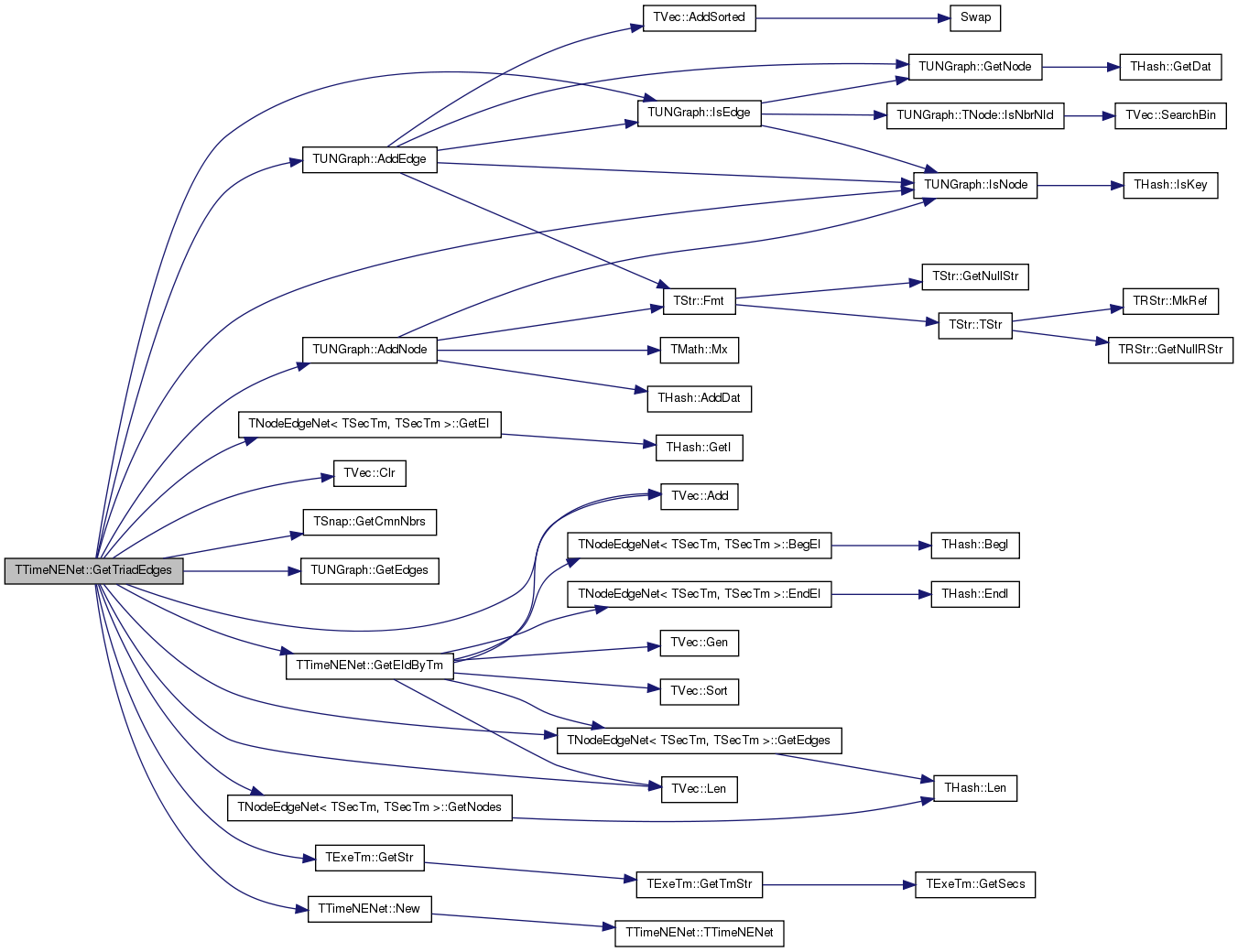
| static PTimeNENet TTimeNENet::Load | ( | TSIn & | SIn | ) | [inline, static] |
Static constructor that loads the network from a stream SIn and returns a pointer to it.
Reimplemented from TNodeEdgeNet< TSecTm, TSecTm >.
Definition at line 88 of file timenet.h.
References TTimeNENet().
{ return new TTimeNENet(SIn); }

| PTimeNENet TTimeNENet::LoadEdgeTm | ( | const TStr & | EdgeFNm, |
| const int & | SrcFld = 0, |
||
| const int & | DstFld = 1, |
||
| const int & | TimeFld = 2, |
||
| const TSsFmt & | Separator = ssfTabSep |
||
| ) | [static] |
Definition at line 1388 of file timenet.cpp.
References TStrHash< TDat, TStringPool, THashFunc >::AddKey(), TStr::CStr(), TSecTm::GetCurTm(), TSsParser::GetFld(), TSecTm::GetStr(), TExeTm::GetStr(), IAssert, TSsParser::IsCmt(), TSsParser::Len(), Mega, TMath::Mn(), TMath::Mx(), New(), and TSsParser::Next().
{
printf("Loading %s\n", EdgeFNm.CStr());
PTimeNENet Net = TTimeNENet::New();
TStrHash<TInt> StrToId(Mega(1), true); // node id to string
int LineCnt=0;
TExeTm ExeTm;
TSsParser Ss(EdgeFNm, Separator);
TSecTm MinTm=TSecTm::GetCurTm(), MaxTm=TSecTm(100);
while (Ss.Next()) {
if (Ss.IsCmt()) { continue; }
IAssert(Ss.Len() > TimeFld);
const char* Node1 = Ss.GetFld(SrcFld);
const char* Node2 = Ss.GetFld(DstFld);
const char* TmStr = Ss.GetFld(TimeFld);
if (strcmp(TmStr,"NULL")==0) { continue; }
//const TSecTm Tm = TSecTm::GetDtTmFromYmdHmsStr(TmStr);
const TSecTm Tm(atoi(TmStr));
const int NId1 = StrToId.AddKey(Node1);
const int NId2 = StrToId.AddKey(Node2);
if (! Net->IsNode(NId1)) { Net->AddNode(NId1, TSecTm()); }
if (! Net->IsNode(NId2)) { Net->AddNode(NId2, TSecTm()); }
MinTm=TMath::Mn(MinTm, Tm);
MaxTm=TMath::Mx(MaxTm, Tm);
Net->AddEdge(NId1, NId2, -1, Tm);
if (++LineCnt % 1000 == 0) {
printf("\r %dk lines processed: %d %d [%s]", LineCnt/1000, Net->GetNodes(), Net->GetEdges(), ExeTm.GetStr()); }
}
printf("\r %d lines processed: %d %d [%s]\n", LineCnt, Net->GetNodes(), Net->GetEdges(), ExeTm.GetStr());
printf(" Data range %s -- %s\n", MinTm.GetStr().CStr(), MaxTm.GetStr().CStr());
//TSnap::PrintInfo(Net, "", "", false);
Net->UpdateNodeTimes();
return Net;
}
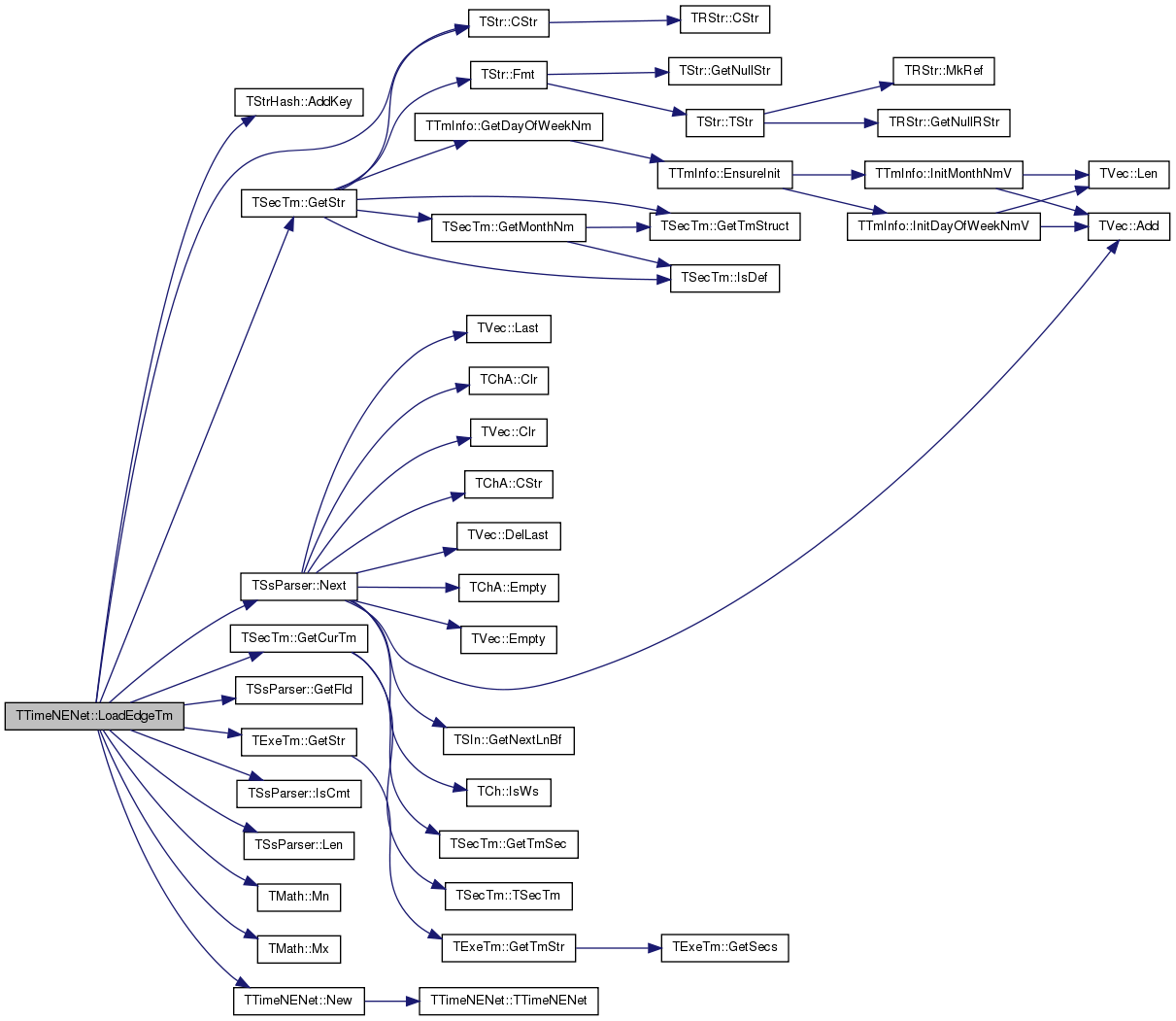
| PTimeNENet TTimeNENet::LoadFlickr | ( | const TStr & | NodeFNm, |
| const TStr & | EdgeFNm | ||
| ) | [static] |
Definition at line 1345 of file timenet.cpp.
References TStr::CStr(), TSsParser::GetInt(), TSsParser::GetLineNo(), TSecTm::GetStr(), New(), TSsParser::Next(), and ssfWhiteSep.
{
const int BegOfTm = 1047369600; // Tue Mar 11 01:00:00 2003 (begining of Flickr)
PTimeNENet Net = TTimeNENet::New();
printf("Adding nodes...");
{ TSsParser Ss(NodeFNm, ssfWhiteSep);
while (Ss.Next()) {
const int NId = Ss.GetInt(0);
const int Tm = Ss.GetInt(1)+BegOfTm;
if (TSecTm(Tm) < TSecTm(2002, 1, 1)) {
printf(" skip node %g (time %d)\n", (double) Ss.GetLineNo(), Ss.GetInt(1)); continue; }
Net->AddNode(NId, TSecTm(Tm));
} }
printf(" %d nodes\n", Net->GetNodes());
printf("Adding edges...");
int SkipCnt=0;
//TIntH SkipDiffCnt;
{ TSsParser Ss(EdgeFNm, ssfWhiteSep);
while (Ss.Next()) {
const int NId1 = Ss.GetInt(0);
const int NId2 = Ss.GetInt(1);
const TSecTm Tm = TSecTm(Ss.GetInt(2)+BegOfTm);
if (! Net->IsNode(NId1) || ! Net->IsNode(NId2)) { printf("not node\n"); continue; }
if (Tm < TSecTm(2002, 1, 1)) { SkipCnt++;
printf(" skip edge %g (time %s)\n", (double) Ss.GetLineNo(), Tm.GetStr().CStr()); continue; }
if (Tm+600 < Net->GetNDat(NId1)) {
printf(" 1:skip edge %g (time %s < %s)\n", (double) Ss.GetLineNo(), Tm.GetStr().CStr(), Net->GetNDat(NId1).GetStr().CStr());
//SkipDiffCnt.AddDat(-Tm.GetAbsSecs()+Net->GetNDat(NId1).GetAbsSecs()) += 1;
SkipCnt++; continue; }
if (Tm+600 < Net->GetNDat(NId2)) { SkipCnt++;
printf(" 2:skip edge %g (time %s < %s)\n", (double) Ss.GetLineNo(), Tm.GetStr().CStr(), Net->GetNDat(NId2).GetStr().CStr());
//SkipDiffCnt.AddDat(-Tm.GetAbsSecs()+Net->GetNDat(NId2).GetAbsSecs()) += 1;
SkipCnt++; continue; }
Net->AddEdge(NId1, NId2, -1, TSecTm(Tm));
} }
//TGnuPlot::PlotValCntH(SkipDiffCnt, "flickr-edgeNodeDiff", "", "seconds", "count");
printf(" %d edges\n", Net->GetEdges());
printf(" %d edges skipped (edge time < node time)\n", SkipCnt);
Net->UpdateNodeTimes();
return Net;
}
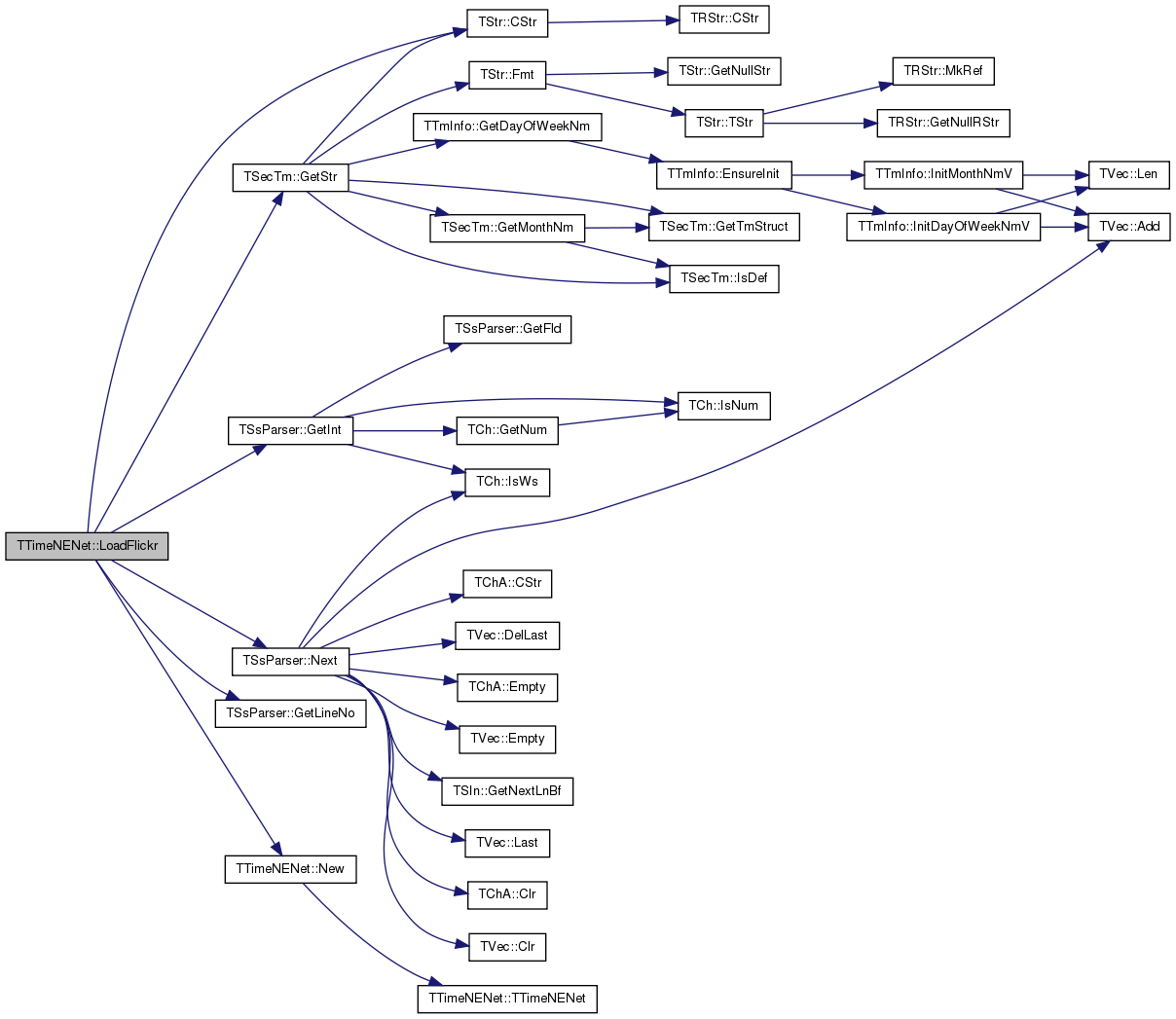
| static PTimeNENet TTimeNENet::New | ( | ) | [inline, static] |
Static constructor that returns a pointer to the network. Call: TPt <TNodeEdgeNet<TNodeData, TEdgeData> > Net = TNodeEdgeNet<TNodeData, TEdgeData>::New().
Reimplemented from TNodeEdgeNet< TSecTm, TSecTm >.
Definition at line 86 of file timenet.h.
References TTimeNENet().
Referenced by Get1stEdgeNet(), GetESubGraph(), GetGnmRndNet(), GetGraphUpToTm(), GetPrefAttach(), GetSmallNet(), GetSubGraph(), GetTimeNet(), GetTriadEdges(), LoadEdgeTm(), LoadFlickr(), and TimeGrowth().
{ return new TTimeNENet(); }

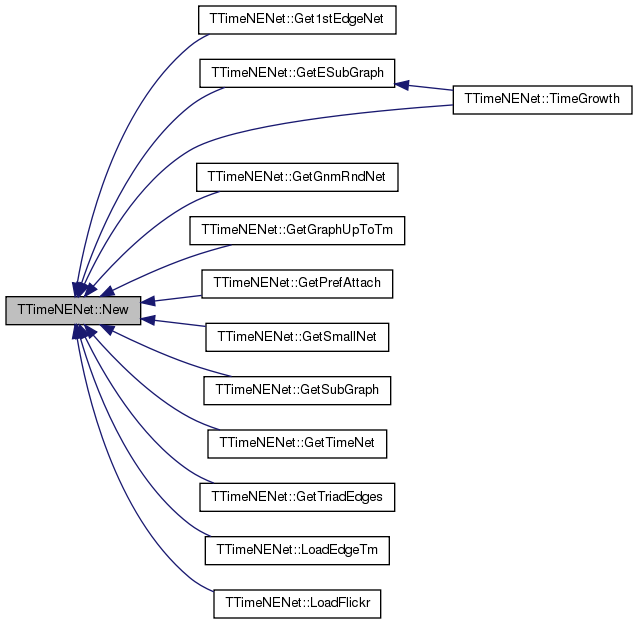
| static PTimeNENet TTimeNENet::New | ( | const int & | Nodes, |
| const int & | Edges | ||
| ) | [inline, static] |
Definition at line 87 of file timenet.h.
References TTimeNENet().
{ return new TTimeNENet(Nodes, Edges); }

| TTimeNENet & TTimeNENet::operator= | ( | const TTimeNENet & | TimeNet | ) |
Definition at line 603 of file timenet.cpp.
References TNodeEdgeNet< TSecTm, TSecTm >::operator=().
{
if (this != &TimeNet) {
TNet::operator=(TimeNet);
}
return *this;
}

| void TTimeNENet::PlotEffDiam | ( | const TStr & | FNmPref, |
| const TStr & | Desc, | ||
| const TTmUnit & | GroupBy, | ||
| const TSecTm & | StartTm, | ||
| const int & | NDiamRuns = 10, |
||
| const bool & | OnlyWcc = false |
||
| ) | const |
Definition at line 932 of file timenet.cpp.
References TVec< TVal, TSizeTy >::Add(), TGnuPlot::AddErrBar(), TVec< TVal, TSizeTy >::AddV(), TStr::CStr(), TStr::Fmt(), TSnap::GetAnfEffDiam(), TNodeEdgeNet< TSecTm, TSecTm >::GetEdges(), GetEdgeTmBuckets(), TSnap::GetMxWcc(), TNGraph::GetNodes(), TNodeEdgeNet< TSecTm, TSecTm >::GetNodes(), TStr::GetNullStr(), TExeTm::GetTmStr(), TTmInfo::GetTmUnitStr(), TVec< TVal, TSizeTy >::Len(), TGnuPlot::SavePng(), TGnuPlot::SetXYLabel(), TVec< TVal, TSizeTy >::Sort(), and TExeTm::Tick().
{
TTimeNet::TTmBucketV TmBucketV;
GetEdgeTmBuckets(TmUnit, TmBucketV);
PNEGraph FullGraph = TSnap::ConvertGraph<PNEGraph>(PTimeNENet((TTimeNENet*)this));
TIntV EdgeIdV;
TExeTm ExeTm, Run1Tm;
TFltTrV TmDiamV, NdsDiamV;
for (int t = 0; t < TmBucketV.Len(); t++) {
EdgeIdV.AddV(TmBucketV[t].NIdV); // edges up to time T
printf("\n*** %s (%d edges)\n", TmBucketV[t].BegTm.GetStr(TmUnit).CStr(), EdgeIdV.Len()); ExeTm.Tick();
if (TmBucketV[t].BegTm < StartTm) continue;
PNGraph PreGraph = TSnap::ConvertESubGraph<PNGraph>(FullGraph, EdgeIdV);
TMom Mom;
double EffDiam = 0.0;
for (int r = 0; r < NDiamRuns; r++) {
printf("%d...", r+1); Run1Tm.Tick();
if (OnlyWcc) { EffDiam = TSnap::GetAnfEffDiam(TSnap::GetMxWcc(PreGraph)); }
else { EffDiam = TSnap::GetAnfEffDiam(PreGraph); }
Mom.Add(EffDiam);
printf("[%s]\r", Run1Tm.GetTmStr());
}
Mom.Def();
TmDiamV.Add(TFltTr(TmBucketV[t].BegTm.Round(TmUnit).GetAbsSecs(), Mom.GetMean(), Mom.GetSDev()));
NdsDiamV.Add(TFltTr(PreGraph->GetNodes(), Mom.GetMean(), Mom.GetSDev()));
NdsDiamV.Sort();
printf(" [%s] \n", ExeTm.GetTmStr());
const TStr WccStr = OnlyWcc ? "WCC " : TStr::GetNullStr();
{ TGnuPlot GnuPlot("diamEff1."+FNmPref, TStr::Fmt("%s. G(%d, %d). %d RUNS.", Desc.CStr(), GetNodes(), GetEdges(), NDiamRuns));
GnuPlot.SetXYLabel(TStr::Fmt("TIME [%s]", TTmInfo::GetTmUnitStr(TmUnit).CStr()), "AVERAGE "+WccStr+"Effective Diameter");
GnuPlot.AddErrBar(TmDiamV, "", "");
GnuPlot.SavePng(); }
{ TGnuPlot GnuPlot("diamEff2."+FNmPref, TStr::Fmt("%s. G(%d, %d). %d RUNS.", Desc.CStr(), GetNodes(), GetEdges(), NDiamRuns));
GnuPlot.SetXYLabel("NODES", "AVERAGE "+WccStr+"Effective Diameter");
GnuPlot.AddErrBar(NdsDiamV, "", "");
GnuPlot.SavePng(); }
}
}
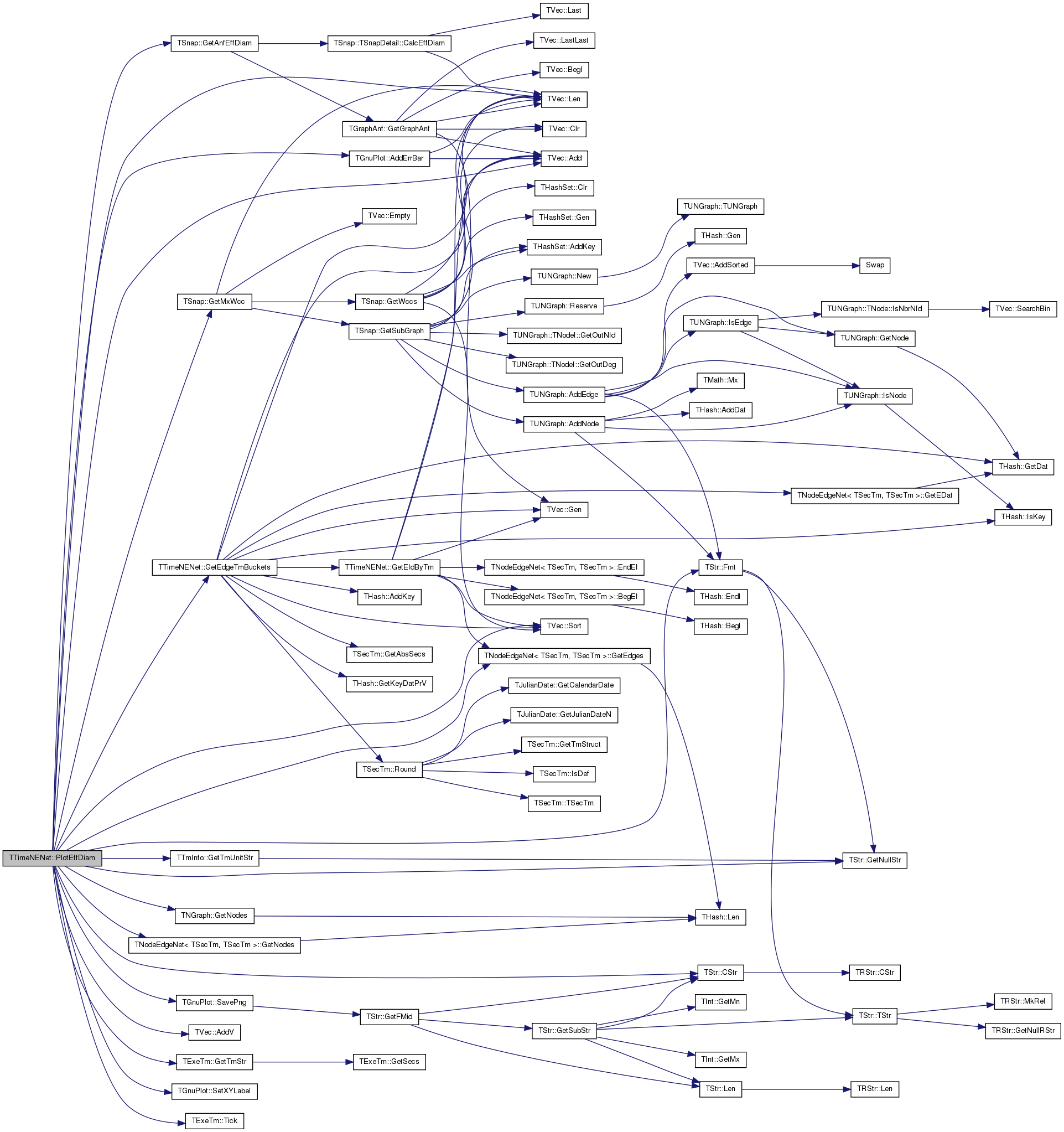
| void TTimeNENet::PlotMissingPast | ( | const TStr & | FNmPref, |
| const TStr & | Desc, | ||
| const TTmUnit & | TmUnit, | ||
| const TSecTm & | DelPreTmEdges, | ||
| const TSecTm & | PostTmDiam, | ||
| const bool & | LinkBWays | ||
| ) |
Definition at line 975 of file timenet.cpp.
References TStr::CStr(), TSecTm::GetStr(), and TTmInfo::GetTmUnitStr().
{
printf("\nGrowth over time: degree distribution, Growth Power Law, Diameter.\n %s group by %s.\n",
FNmPref.CStr(), TTmInfo::GetTmUnitStr(TmUnit).CStr());
printf(" Delete out-edges of pre time %s nodes.\n Take subgraph of post year %s subgraph.\n\n",
DelPreTmEdges.GetStr().CStr(), PostTmDiam.GetStr().CStr());
// run diameter
/*const int NSamples = 100;
const int NDiamRuns = 10;
// delete past
if (DelPreEdges != -1) {
TIntV EdgeIdV;
printf("Deleting pre-year %d edges\n", DelPreEdges);
for (TEdgeI EI = BegEI(); EI < EndEI(); EI++) {
if (EI().GetYear() < DelPreEdges) { EdgeIdV.Add(EI.GetId()); } }
for (int e = 0; e < EdgeIdV.Len(); e++) { DelEdge(EdgeIdV[e]); }
printf(" Deleted %d edges (out of %d edges total).\n", EdgeIdV.Len(), GetEdges());
}
PNEGraph FullGraph = GetNEGraph();
TSnap::DelZeroDegNodes(FullGraph);
PGrowthStat GrowthStat = TGrowthStat::New(TmUnit, TGraphStat::AllStat());
TFltV PreDiamSDev, PreEffDiamSDev, WccDiamSDev, WccEffDiamSDev;
TIntV EdgeIdV;
TExeTm ExeTm;
TTimeNet::TTmBucketV EdgeTmBucketV;
GetEdgeTmBuckets(TmUnit, EdgeTmBucketV);
for (int t = 0; t < EdgeTmBucketV.Len(); t++) {
printf("\nGraph: %s (%d / %d) [%s]\n", EdgeTmBucketV[t].BegTm.GetTmStr().CStr(),
t+1, EdgeTmBucketV.Len(), TExeTm::GetCurTm());
// up-to-year subgraph
EdgeIdV.AddV(EdgeTmBucketV[t].NIdV); // nodes up to time T
if (EdgeTmBucketV[t].BegTm.GetYear() < PostYearDiam) continue;
const PNEGraph PreNEGraph = EdgeBothWays ? FullGraph->GetEdgeSubGraph(EdgeIdV) : FullGraph;
PNGraph PreGraph = PreNEGraph->GetBWayGraph();
PNGraph WccGraph = TSnap::GetMxWcc(PreGraph);
// find nodes that are not in missing past
TIntV PostYearNIdV, WccPostYearNIdV;
THash<TIntPr, TInt> PostYearEdgeH;
for (TNEGraph::TEdgeI EI = PreNEGraph->BegEI(); EI < PreNEGraph->EndEI(); EI++) {
if (GetEDat(EI.GetId()).GetYear() >= PostYearDiam) {
PostYearEdgeH.AddKey(TIntPr(EI.GetSrcNId(), EI.GetDstNId())); }
}
TIntH PostYearNIdH;
for (int i = 0; i < PostYearEdgeH.Len(); i++) {
if ((! EdgeBothWays) || (EdgeBothWays && PostYearEdgeH.IsKey(TIntPr(PostYearEdgeH.GetKey(i).Val2, PostYearEdgeH.GetKey(i).Val1)))) { //reverse edge exists
PostYearNIdH.AddKey(PostYearEdgeH.GetKey(i).Val1);
PostYearNIdH.AddKey(PostYearEdgeH.GetKey(i).Val2);
}
}
PostYearNIdH.GetKeyV(PostYearNIdV);
for (int i = 0; i < PostYearNIdV.Len(); i++) {
if (WccGraph->IsNode(PostYearNIdV[i])) {
WccPostYearNIdV.Add(PostYearNIdV[i]); }
}
// diameter of PostYearDiam subgraph using whole graph (all edges)
TMom PreDiamMom, PreEffDiamMom, WccDiamMom, WccEffDiamMom;
for (int r = 0; r < NDiamRuns; r++) {
if (! PostYearNIdV.Empty()) {
PreDiamMom.Add(-1); //PreDiamMom.Add(TSnap::GetBfsFullDiam(PreGraph, NSamples, PostYearNIdV, false));
PreEffDiamMom.Add(TSnap::GetBfsEffDiam(PreGraph, NSamples, PostYearNIdV, false));
}
if (! WccPostYearNIdV.Empty()) {
//WccDiamMom.Add(TSnap::GetBfsFullDiam(WccGraph, NSamples, WccPostYearNIdV, false));
//WccEffDiamMom.Add(TSnap::GetBfsEffDiam(WccGraph, NSamples, WccPostYearNIdV, false));
WccDiamMom.Add(-1); WccEffDiamMom.Add(-1);
}
printf(" diam: %d [%s] %.2f\r", r+1, ExeTm.GetTmStr(), PreEffDiamMom.GetValV().Last().Val); ExeTm.Tick();
}
PreDiamMom.Def(); PreEffDiamMom.Def();
WccDiamMom.Def(); WccEffDiamMom.Def();
// save stat
PGraphStat GraphStatPt = GrowthStat->Add(EdgeTmBucketV[t].BegTm);
TGraphStat& GraphStat = *GraphStatPt;
GraphStat.Nodes = PreGraph->GetNodes();
GraphStat.NonZNodes = PreGraph->GetNodes() - TSnap::CntDegNodes<PNGraph>(PreGraph, 0);
GraphStat.Srcs = GraphStat.Nodes - TSnap::CntOutDegNodes<PNGraph>(PreGraph, 0);
GraphStat.Edges = PreGraph->GetEdges();
GraphStat.WccNodes= WccGraph->GetNodes();
GraphStat.WccEdges = WccGraph->GetEdges();
GraphStat.FullDiam = PreDiamMom.GetMean(); // mean
GraphStat.EffDiam = PreEffDiamMom.GetMean();
GraphStat.FullWccDiam = WccDiamMom.GetMean();
GraphStat.EffWccDiam = WccEffDiamMom.GetMean();
GraphStat.FullDiamDev = PreDiamMom.GetSDev(); // variance
GraphStat.EffDiamDev = PreEffDiamMom.GetSDev();
GraphStat.FullWccDiamDev = WccDiamMom.GetSDev();
GraphStat.EffWccDiamDev = WccEffDiamMom.GetSDev();
{ TFOut FOut("growth."+FNmPref+".bin");
GrowthStat->Save(FOut); }
const TStr BigDesc = TStr::Fmt("%s. MISSING PAST DIAMETER\nDelPreEdges\t%d\nPostYearDiam\t%d\n",
Desc.CStr(), DelPreEdges, PostYearDiam);
GrowthStat->SaveTxt(FNmPref, BigDesc);
}
// diameter plots
GrowthStat->PlotDiam(FNmPref, Desc + TStr::Fmt(" MISSING PAST. DelPre:%d PostYear:%d.",
DelPreEdges, PostYearDiam));
*/
}

| void TTimeNENet::Save | ( | TSOut & | SOut | ) | const [inline, virtual] |
Saves the network to a (binary) stream SOut.
Reimplemented from TNodeEdgeNet< TSecTm, TSecTm >.
Definition at line 85 of file timenet.h.
References TNodeEdgeNet< TSecTm, TSecTm >::Save().
{ TNet::Save(SOut); }

| void TTimeNENet::SaveEdgeTm | ( | const TStr & | EdgeFNm, |
| const bool & | RenumberNId = false, |
||
| const bool & | RelativeTm = false |
||
| ) | const |
Definition at line 1308 of file timenet.cpp.
References THashSet< TKey, THashFunc >::AddKey(), TStr::CStr(), THashSet< TKey, THashFunc >::Gen(), TSecTm::GetAbsSecs(), TNodeEdgeNet< TSecTm, TSecTm >::GetEDat(), TNodeEdgeNet< TSecTm, TSecTm >::GetEI(), GetEIdByTm(), THashSet< TKey, THashFunc >::GetKeyId(), TNodeEdgeNet< TSecTm, TSecTm >::GetNodes(), and TVec< TVal, TSizeTy >::Len().
{
TIntV EIdV; GetEIdByTm(EIdV);
const int BegTm = RelativeTm ? GetEDat(EIdV[0]).GetAbsSecs() : 0;
TIntSet NIdMap;
if (RenumberNId) { NIdMap.Gen(GetNodes()); }
FILE *F = fopen(EdgeFNm.CStr(), "wt");
//fprintf(F, "#Nodes\t%d\n#Edges\t%d\n", GetNodes(), GetEdges());
//fprintf(F, "#<src>\t<dst>\t<time>\n");
for (int e =0; e < EIdV.Len(); e++) {
const TEdgeI EI = GetEI(EIdV[e]);
if (RenumberNId) {
const int src = EI.GetSrcNId();
const int dst = EI.GetDstNId();
NIdMap.AddKey(src); NIdMap.AddKey(dst);
fprintf(F, "%d\t%d\t%d\n", NIdMap.GetKeyId(src), NIdMap.GetKeyId(dst), EI().GetAbsSecs()-BegTm);
}else {
fprintf(F, "%d\t%d\t%d\n", EI.GetSrcNId(), EI.GetDstNId(), EI().GetAbsSecs()-BegTm); }
}
fclose(F);
}
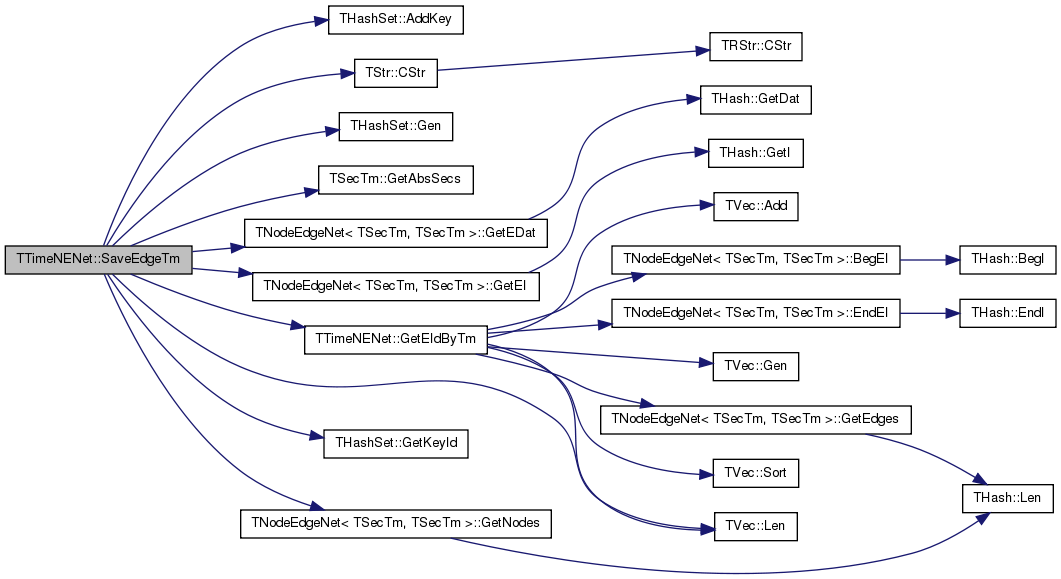
| void TTimeNENet::SetNodeTmToFirstEdgeTm | ( | ) |
Definition at line 723 of file timenet.cpp.
References TNodeEdgeNet< TSecTm, TSecTm >::BegNI(), TNodeEdgeNet< TSecTm, TSecTm >::EndNI(), TNodeEdgeNet< TSecTm, TSecTm >::GetEDat(), TNodeEdgeNet< TSecTm, TSecTm >::GetNDat(), TNodeEdgeNet< TSecTm, TSecTm >::GetNodes(), IAssert, and TSecTm::IsDef().
{
int Cnt = 0;
for (TNodeI NI = BegNI(); NI < EndNI(); NI++) {
if (NI.GetDeg() == 0) { continue; }
TSecTm NodeTm;
for (int edge = 0; edge < NI.GetOutDeg(); edge++) {
const TSecTm& EdgeTm = GetEDat(NI.GetOutEId(edge)); IAssert(EdgeTm.IsDef());
if (! NodeTm.IsDef() || EdgeTm < NodeTm) { NodeTm = EdgeTm; Cnt++; }
}
for (int edge = 0; edge < NI.GetInDeg(); edge++) {
const TSecTm& EdgeTm = GetEDat(NI.GetInEId(edge)); IAssert(EdgeTm.IsDef());
if (! NodeTm.IsDef() || EdgeTm < NodeTm) { NodeTm = EdgeTm; Cnt++; }
}
GetNDat(NI.GetId()) = NodeTm;
}
printf("Node times set: %d/%d updates\n", Cnt, GetNodes());
}
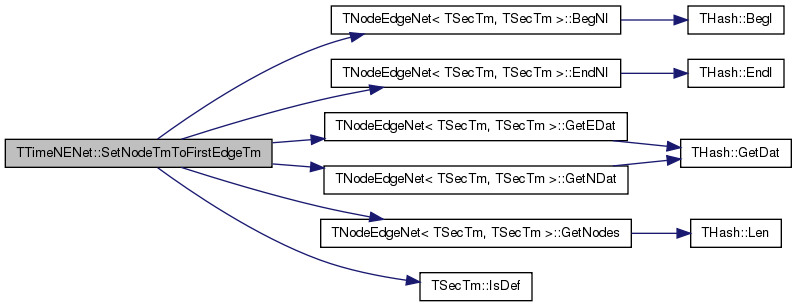
| void TTimeNENet::SetRndEdgeTimes | ( | const int & | MinTmEdge = 0 | ) |
Definition at line 742 of file timenet.cpp.
References TVec< TVal, TSizeTy >::Add(), TNodeEdgeNet< TSecTm, TSecTm >::GetEDat(), TNodeEdgeNet< TSecTm, TSecTm >::GetEdges(), GetEIdByTm(), TVec< TVal, TSizeTy >::Len(), TInt::Rnd, TVec< TVal, TSizeTy >::Swap(), and UpdateNodeTimes().
{
printf("Shuffling last %d (%d%%) edge arrival times..\n", GetEdges()-MinTmEdge, int(100.0*(GetEdges()-MinTmEdge)/double(GetEdges())));
TIntV RndEIdV; GetEIdByTm(RndEIdV);
TIntV TrueEIdV = RndEIdV;
TSecTmV TrueTmV;
const int SwapLen = RndEIdV.Len()-MinTmEdge;
for (int R = 0; R < 10; R++) {
for (int i = MinTmEdge; i < RndEIdV.Len(); i++) {
RndEIdV.Swap(TInt::Rnd.GetUniDevInt(SwapLen)+MinTmEdge, TInt::Rnd.GetUniDevInt(SwapLen)+MinTmEdge); }
}
for (int e = 0; e < TrueEIdV.Len(); e++) {
TrueTmV.Add(GetEDat(TrueEIdV[e])); }
for (int e = 0; e < RndEIdV.Len(); e++) {
GetEDat(RndEIdV[e]) = TrueTmV[e]; }
UpdateNodeTimes();
}
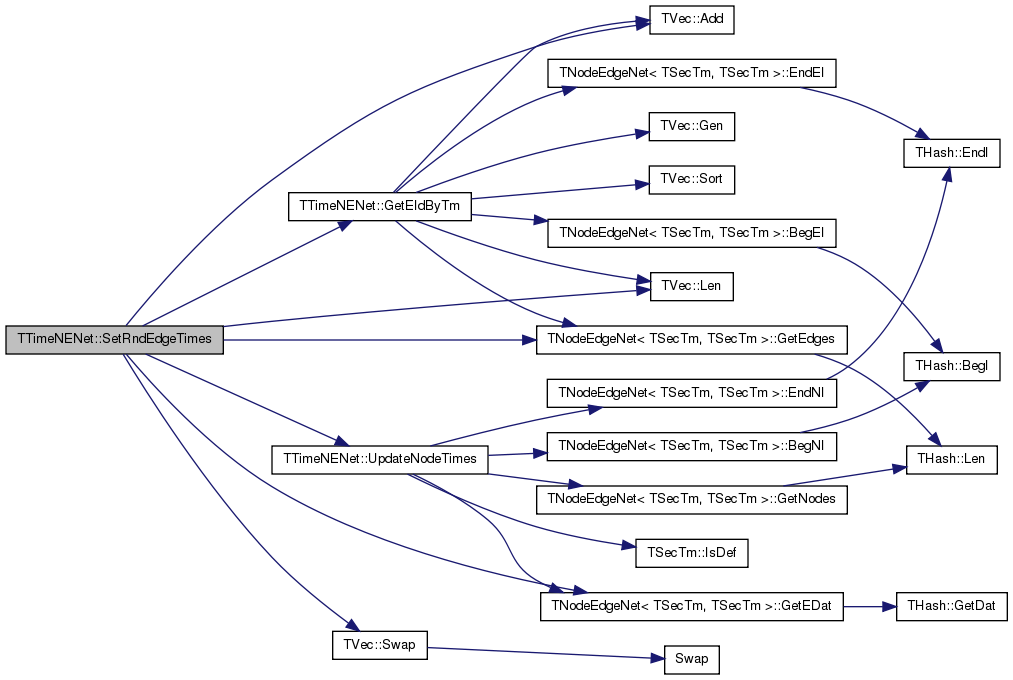
| void TTimeNENet::SortNodeEdgeTimes | ( | ) |
Definition at line 701 of file timenet.cpp.
References TNodeEdgeNet< TSecTm, TSecTm >::EdgeH, TNodeEdgeNet< TSecTm, TSecTm >::NodeH, and THash< TKey, TDat, THashFunc >::SortByDat().

| PGStatVec TTimeNENet::TimeGrowth | ( | const TTmUnit & | TimeStep, |
| const TFSet & | TakeStat, | ||
| const TSecTm & | StartTm = TSecTm(1) |
||
| ) | const |
Definition at line 876 of file timenet.cpp.
References TVec< TVal, TSizeTy >::AddV(), GetEdgeTmBuckets(), GetESubGraph(), TExeTm::GetTmStr(), TVec< TVal, TSizeTy >::Len(), New(), and TExeTm::Tick().
{
TExeTm ExeTm;
PGStatVec GStatVec = TGStatVec::New(TimeStep, TakeStat);
TTimeNet::TTmBucketV TmBucketV;
GetEdgeTmBuckets(TimeStep, TmBucketV);
const PNEGraph FullGraph = TSnap::ConvertGraph<PNEGraph>(PTimeNENet((TTimeNENet*)this));
TIntV EdgeIdV;
for (int t = 0; t < TmBucketV.Len(); t++) {
EdgeIdV.AddV(TmBucketV[t].NIdV); // edges up to time T
printf("\n***%d/%d: %s (%d edges) ", t+1, TmBucketV.Len(), TmBucketV[t].BegTm.GetStr().CStr(), EdgeIdV.Len()); ExeTm.Tick();
if (TmBucketV[t].BegTm < StartTm) { continue; }
const PNEGraph PreGraph = TSnap::GetESubGraph(FullGraph, EdgeIdV);
GStatVec->Add(PreGraph, TmBucketV[t].BegTm);
printf(" [%s]\n", ExeTm.GetTmStr());
//{ TFOut FOut("LinkedIn.GStatVec"); GStatVec->Save(FOut); }
}
return GStatVec;
}
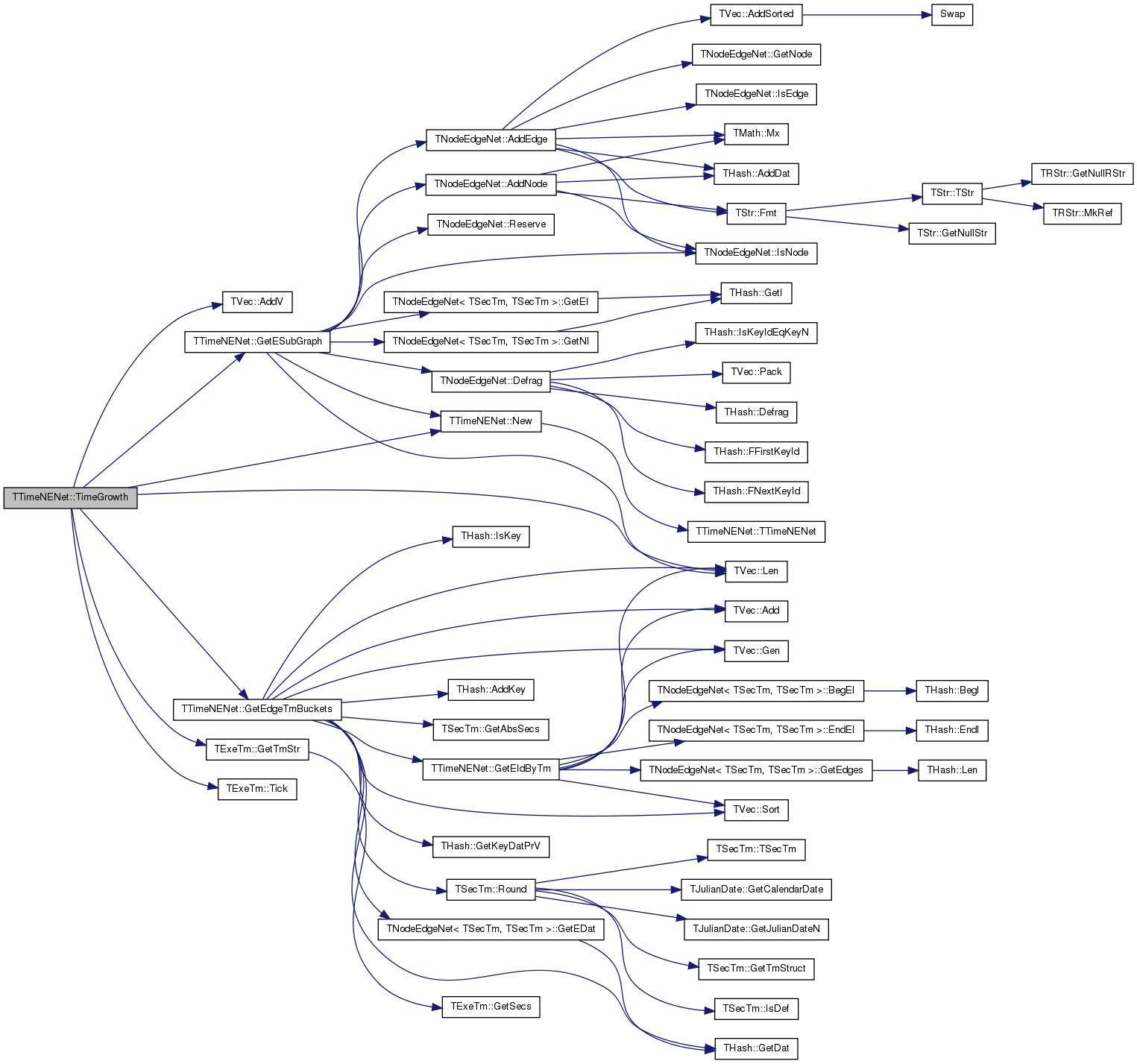
| PGStatVec TTimeNENet::TimeGrowth | ( | const TStr & | FNmPref, |
| const TStr & | Desc, | ||
| const TFSet & | TakeStat, | ||
| const int & | NDiamRuns, | ||
| const TTmUnit & | TmUnit, | ||
| const int & | TakeNTmUnits, | ||
| const bool & | LinkBWays | ||
| ) | const |
Definition at line 896 of file timenet.cpp.
References TVec< TVal, TSizeTy >::Add(), TVec< TVal, TSizeTy >::AddV(), TVec< TVal, TSizeTy >::Clr(), TStr::CStr(), TStr::Fmt(), GetEdgeTmBuckets(), GetESubGraph(), TExeTm::GetTmStr(), TVec< TVal, TSizeTy >::Len(), TGStat::NDiamRuns, New(), TPt< TRec >::Save(), and TExeTm::Tick().
{
TGStat::NDiamRuns = NDiamRuns;
PGStatVec GrowthStat = TGStatVec::New(TmUnit, TakeStat);
TTimeNet::TTmBucketV TmBucketV;
GetEdgeTmBuckets(TmUnit, TmBucketV);
TIntV EdgeIdV;
TExeTm ExeTm;
for (int t = 0; t < TmBucketV.Len(); t++) {
// take graph over last TakeNTmUnits time units
if (TakeNTmUnits == -1) {
EdgeIdV.AddV(TmBucketV[t].NIdV); }
else {
if (t < TakeNTmUnits) { continue; }
EdgeIdV.Clr(false);
for (int i = t-TakeNTmUnits; i < t; i++) { EdgeIdV.AddV(TmBucketV[i].NIdV); }
}
printf("*** %s (%d edges)\n", TmBucketV[t].BegTm.GetStr().CStr(), EdgeIdV.Len()); ExeTm.Tick();
PNEGraph PreGraph = TSnap::ConvertESubGraph<PNEGraph>(PTimeNENet((TTimeNENet*)this), EdgeIdV);
if (LinkBWays) {
TIntV KeepEIdV; // keep only nodes that have in- and out-links (send and receive email)
for (TNEGraph::TEdgeI EI = PreGraph->BegEI(); EI < PreGraph->EndEI(); EI++) {
if (PreGraph->IsEdge(EI.GetDstNId(), EI.GetSrcNId(), true)) { KeepEIdV.Add(EI.GetId()); }
}
PreGraph = TSnap::GetESubGraph(PreGraph, KeepEIdV);
}
// take statistics
GrowthStat->Add(PreGraph, TmBucketV[t].BegTm);
{ TFOut FOut(TStr::Fmt("growth.%s.gStatVec", FNmPref.CStr()));
GrowthStat->Save(FOut); }
GrowthStat->SaveTxt(FNmPref, Desc);
printf(" [%s]\n", ExeTm.GetTmStr());
}
return GrowthStat;
}
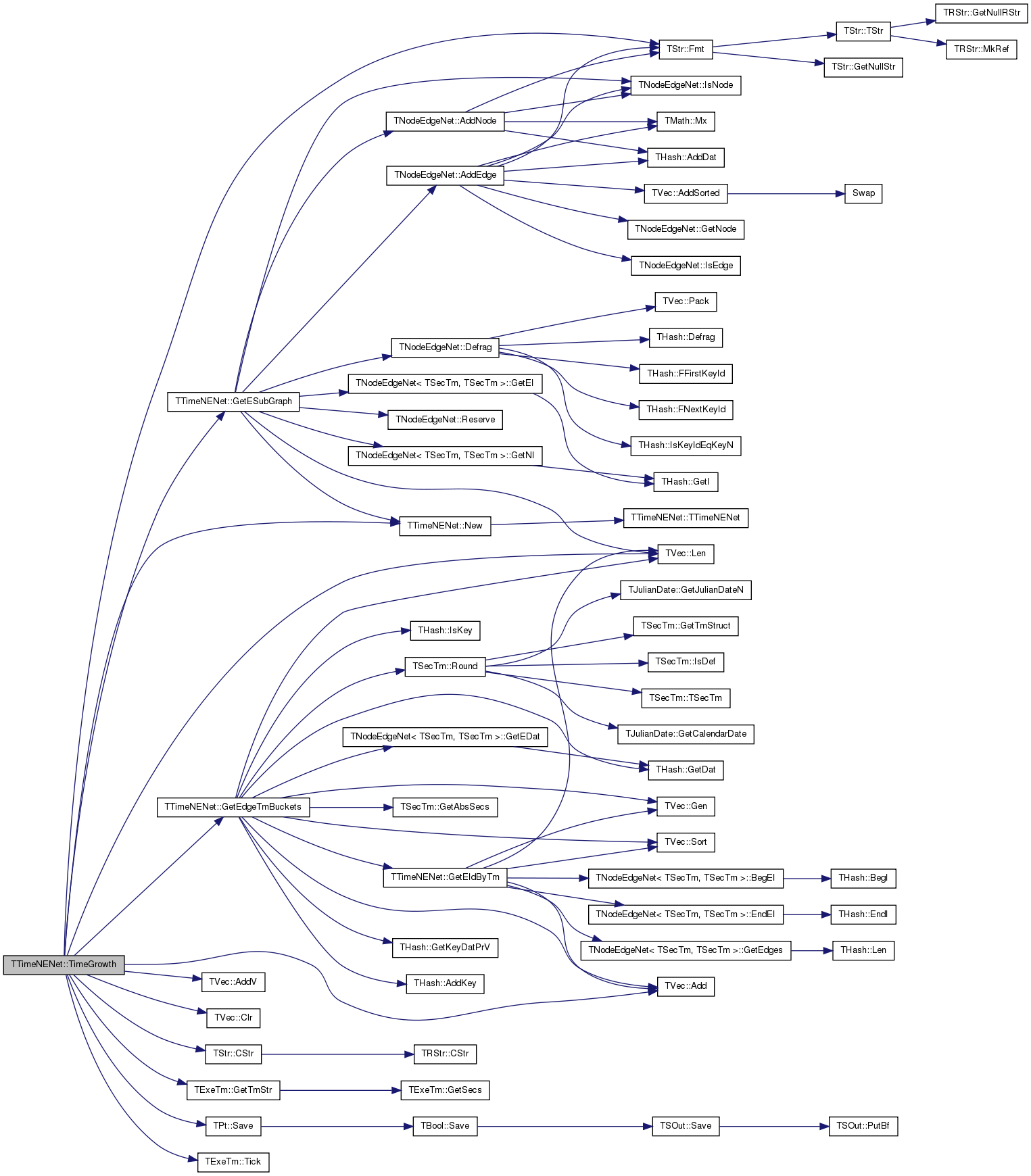
| void TTimeNENet::UpdateNodeTimes | ( | ) |
Definition at line 707 of file timenet.cpp.
References TNodeEdgeNet< TSecTm, TSecTm >::BegNI(), TNodeEdgeNet< TSecTm, TSecTm >::EndNI(), TNodeEdgeNet< TSecTm, TSecTm >::GetEDat(), TNodeEdgeNet< TSecTm, TSecTm >::GetNodes(), and TSecTm::IsDef().
Referenced by SetRndEdgeTimes().
{
int Cnt = 0;
for (TNodeI NI = BegNI(); NI < EndNI(); NI++) {
TSecTm& NodeTm = NI();
for (int edge = 0; edge < NI.GetOutDeg(); edge++) {
const TSecTm& EdgeTm = GetEDat(NI.GetOutEId(edge));
if (! NodeTm.IsDef() || EdgeTm < NodeTm) { NodeTm = EdgeTm; Cnt++; }
}
for (int edge = 0; edge < NI.GetInDeg(); edge++) {
const TSecTm& EdgeTm = GetEDat(NI.GetInEId(edge));
if (! NodeTm.IsDef() || EdgeTm < NodeTm) { NodeTm = EdgeTm; Cnt++; }
}
}
printf("Update node times: %d/%d updates\n", Cnt, GetNodes());
}
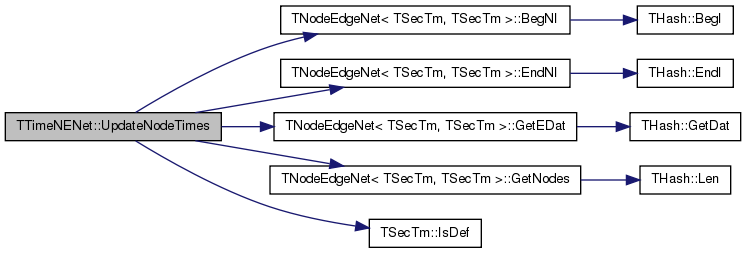

friend class TPt< TTimeNENet > [friend] |